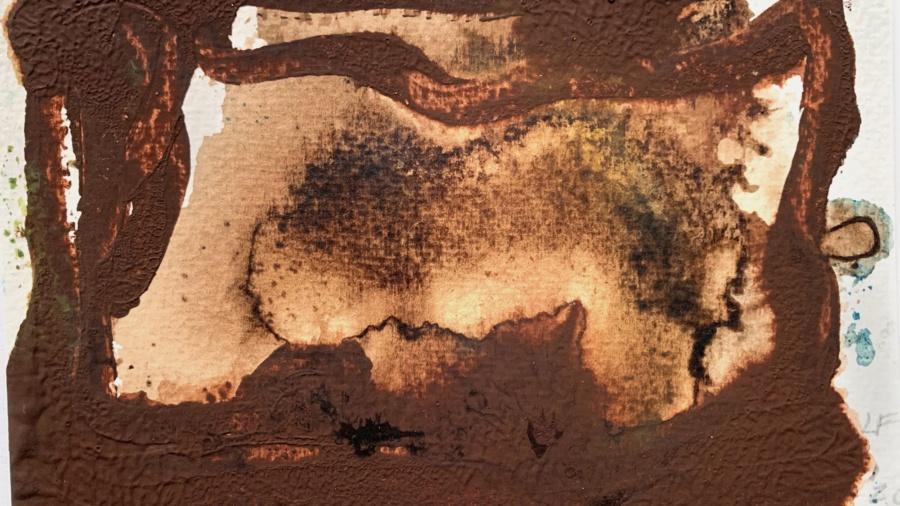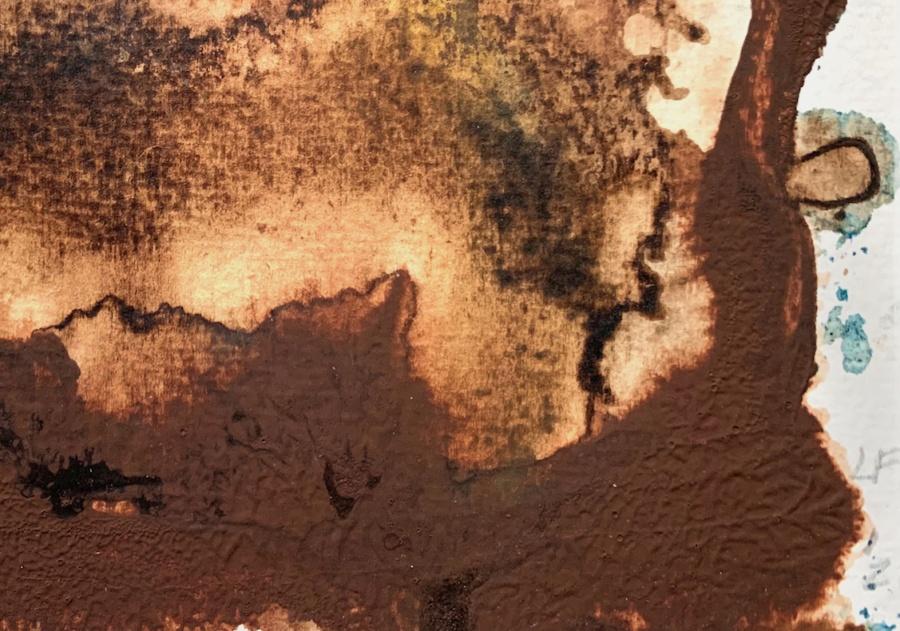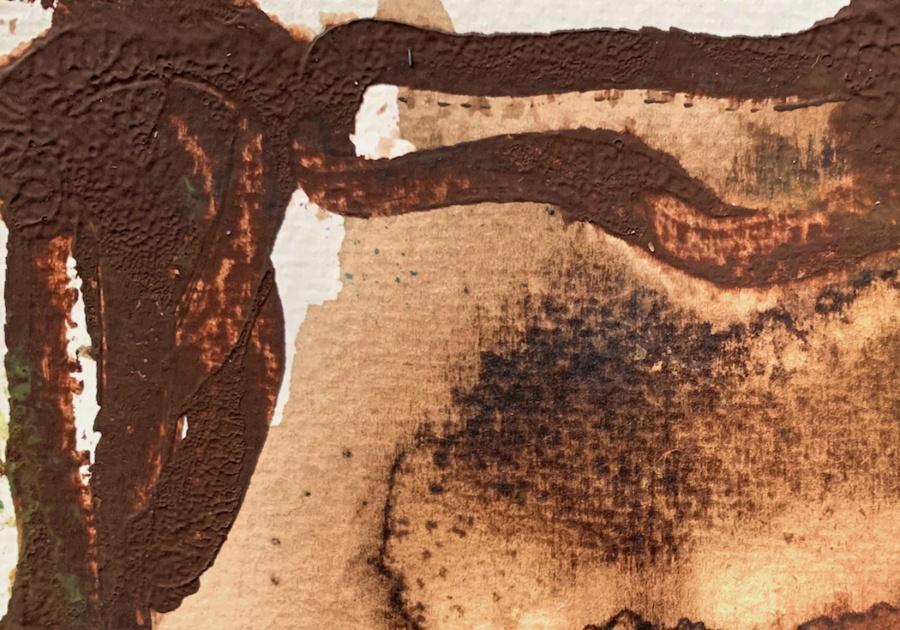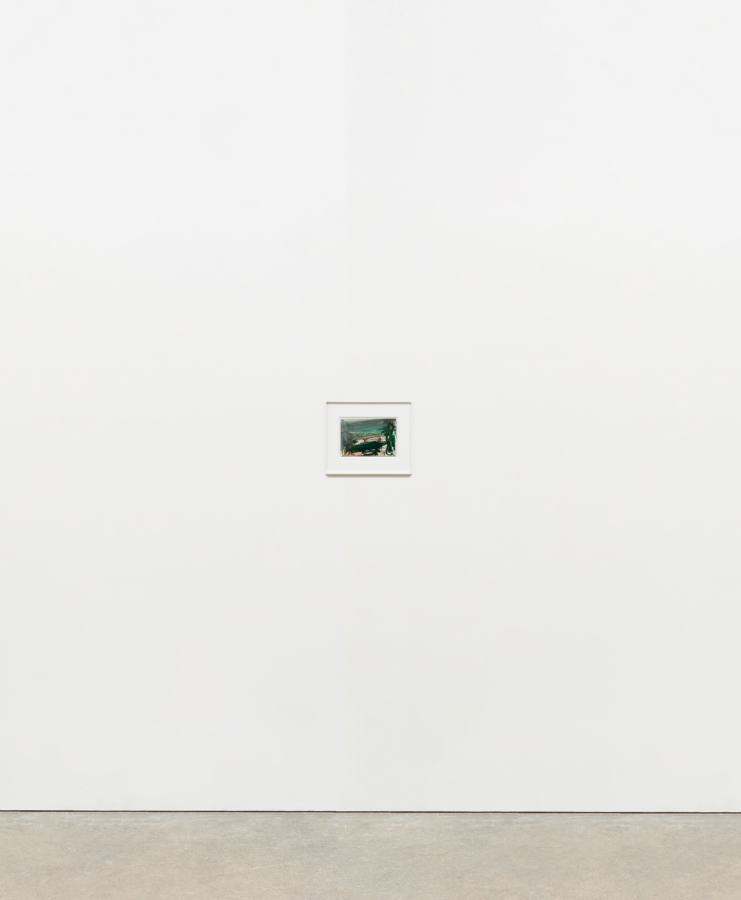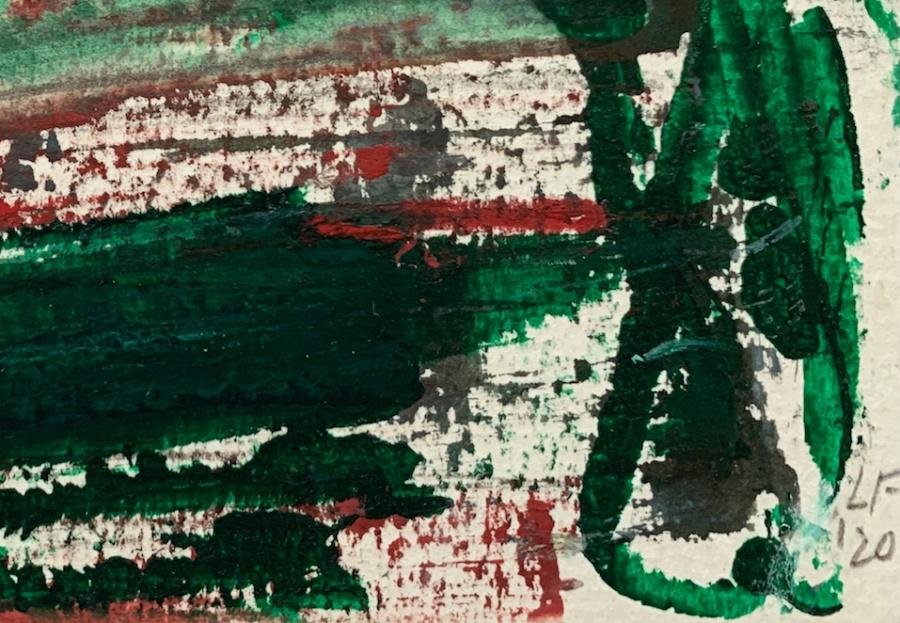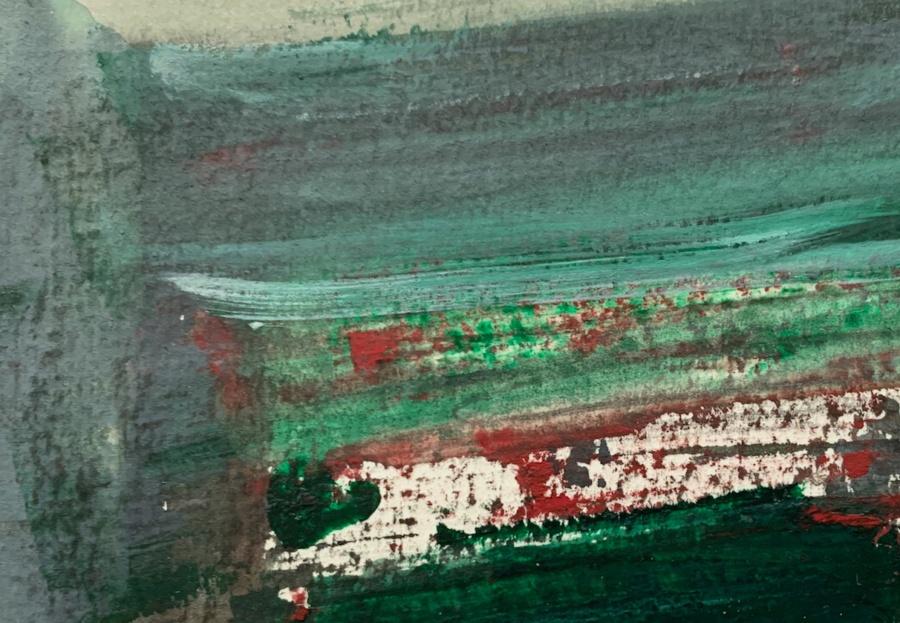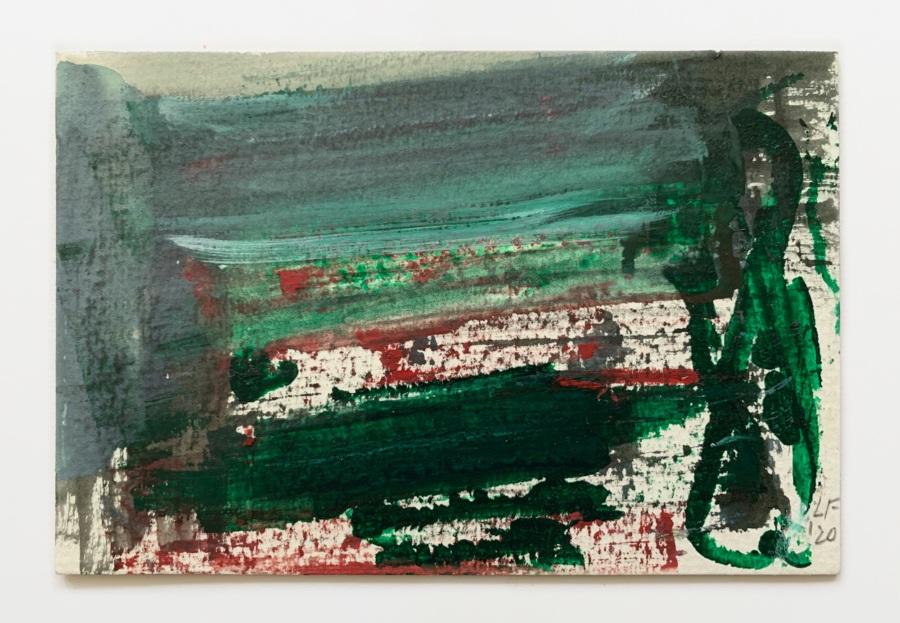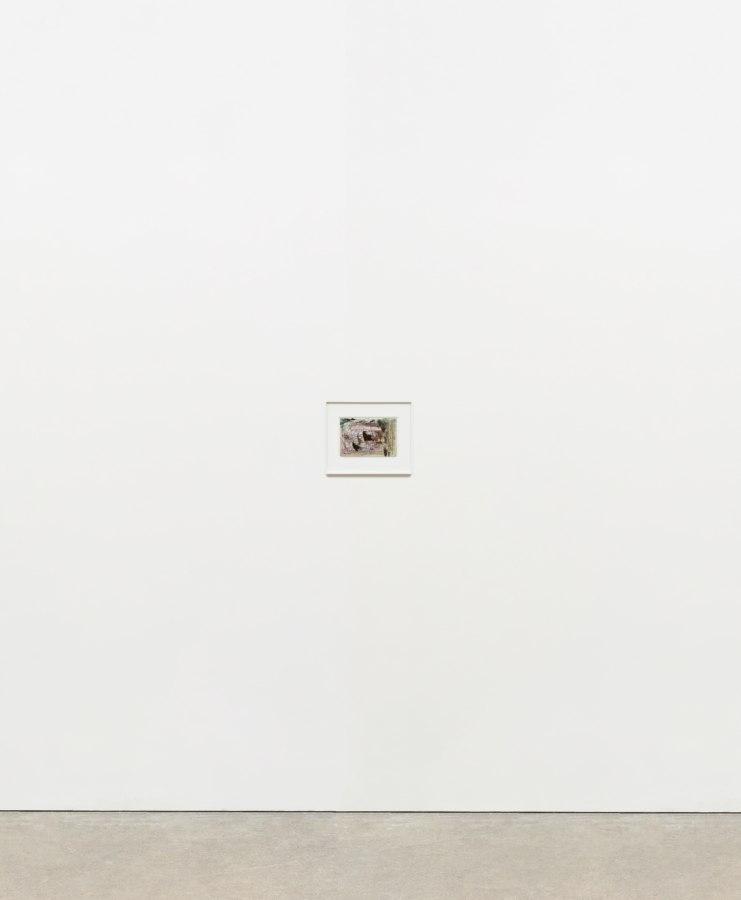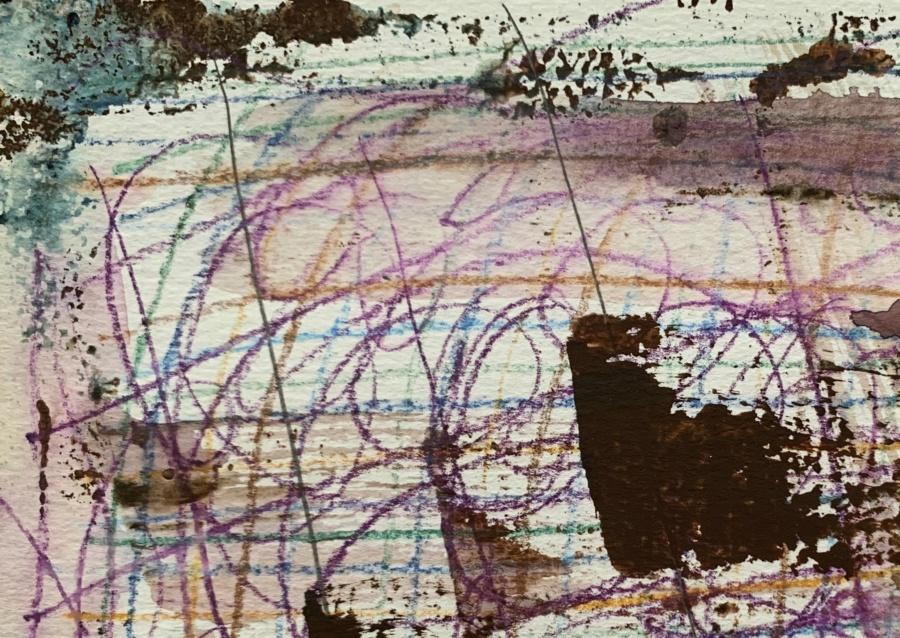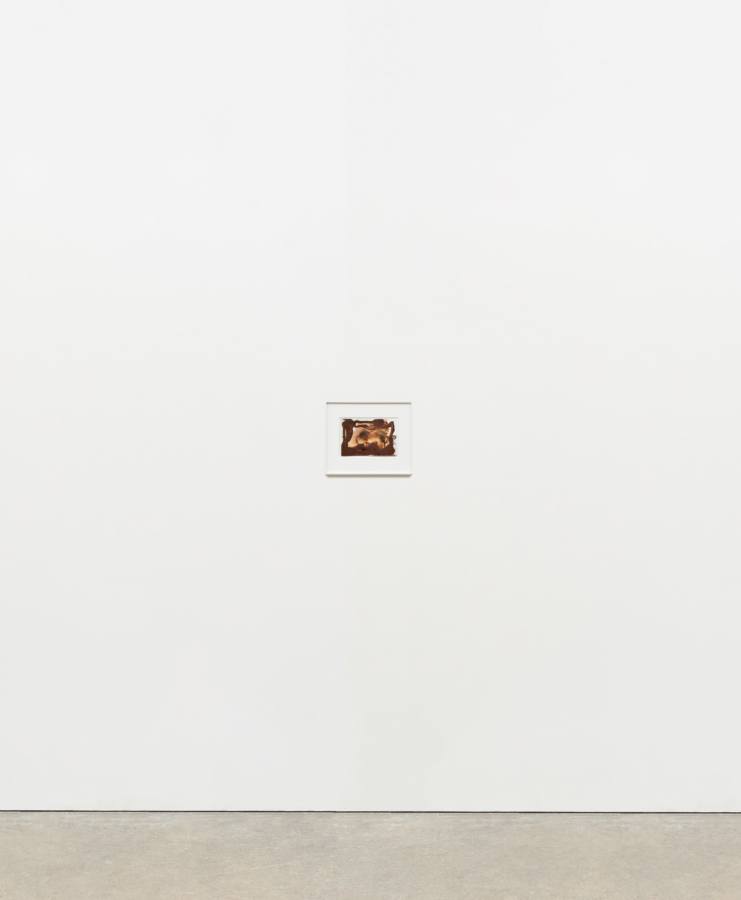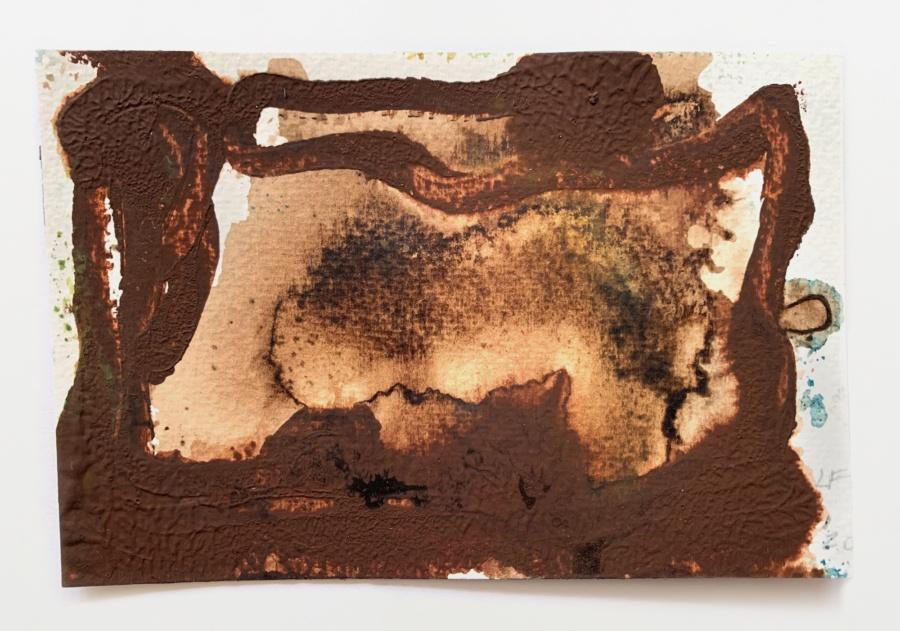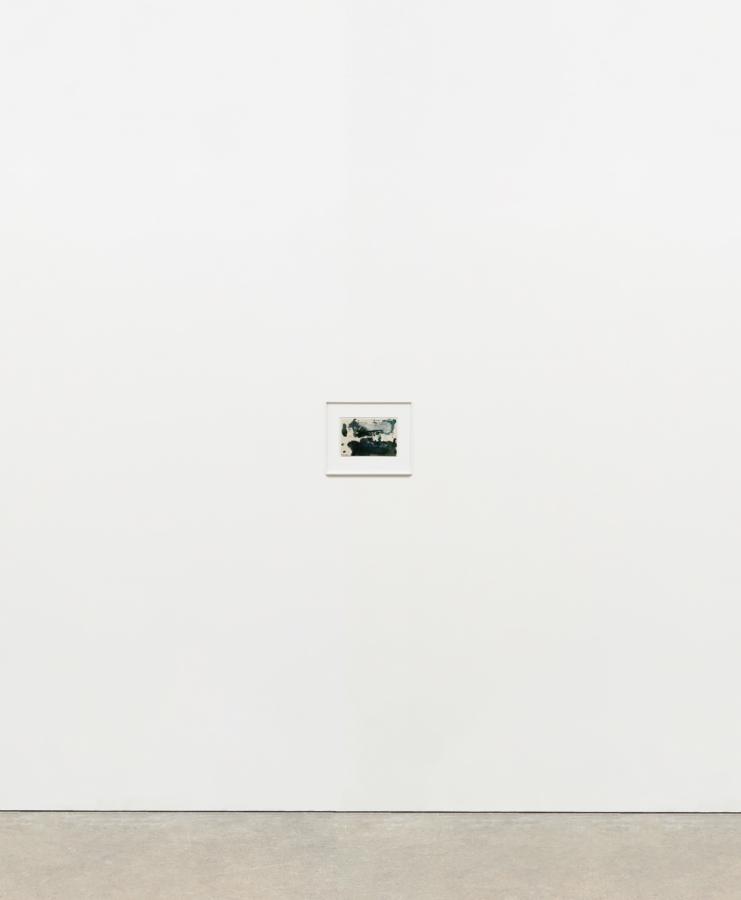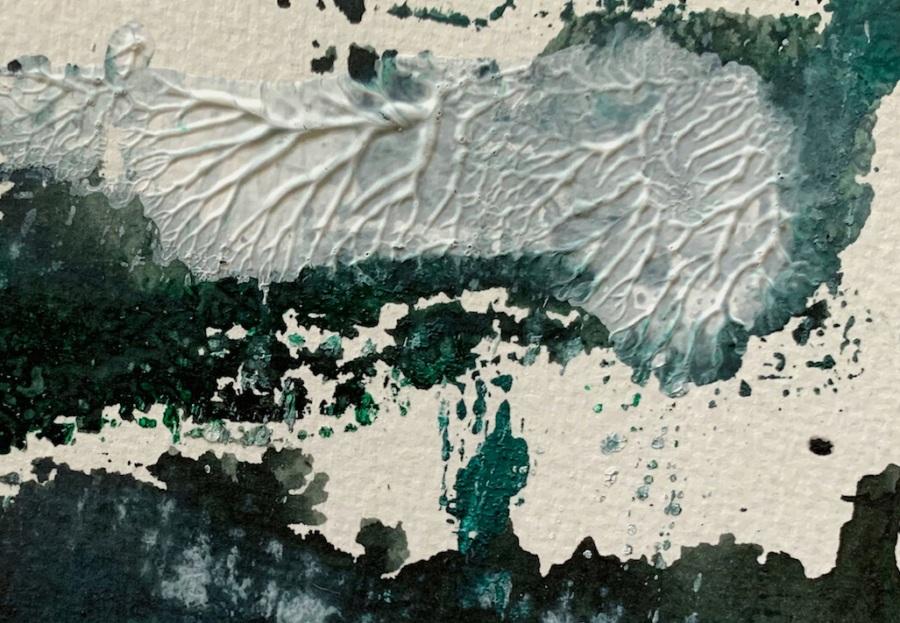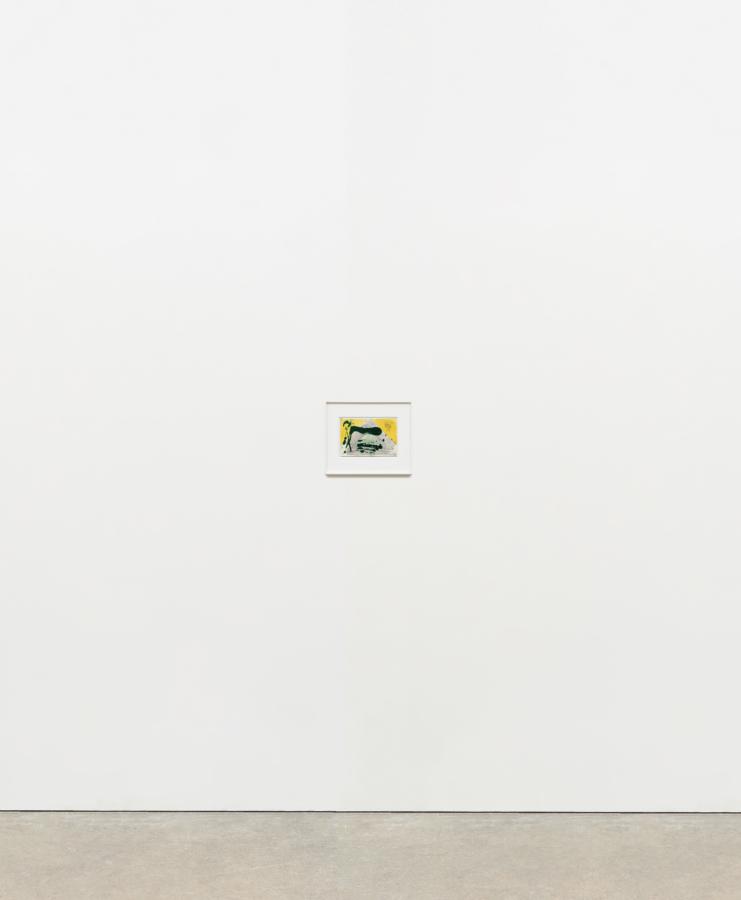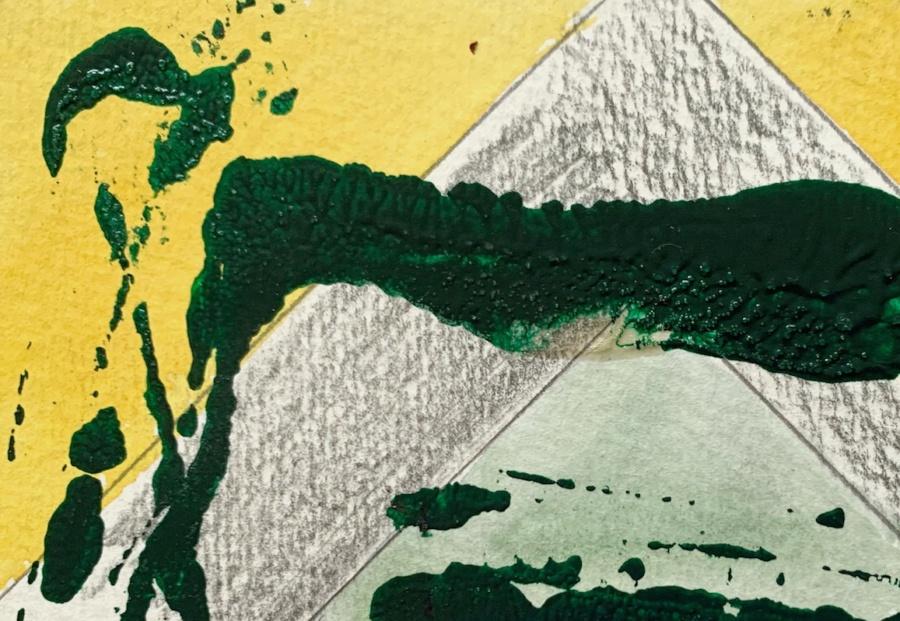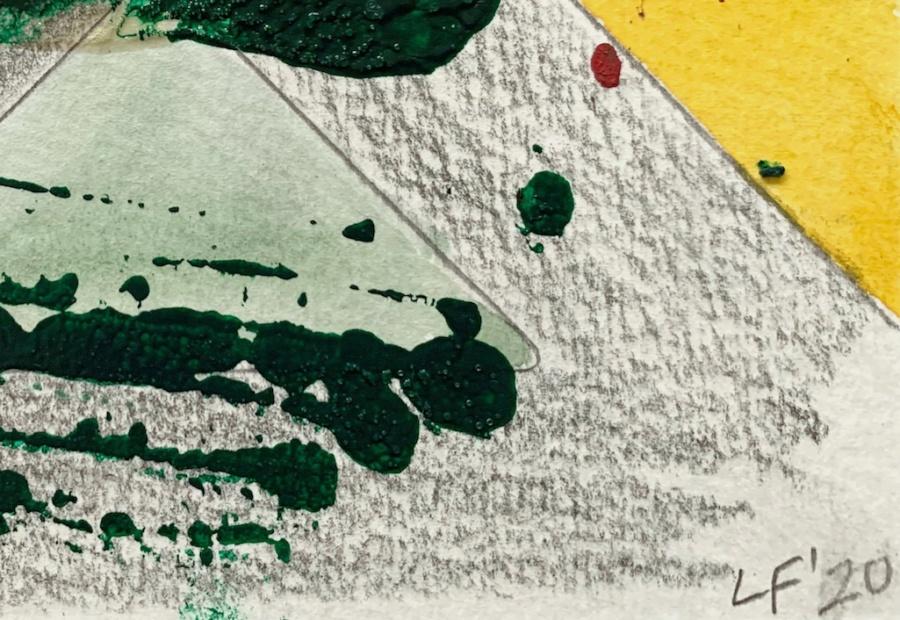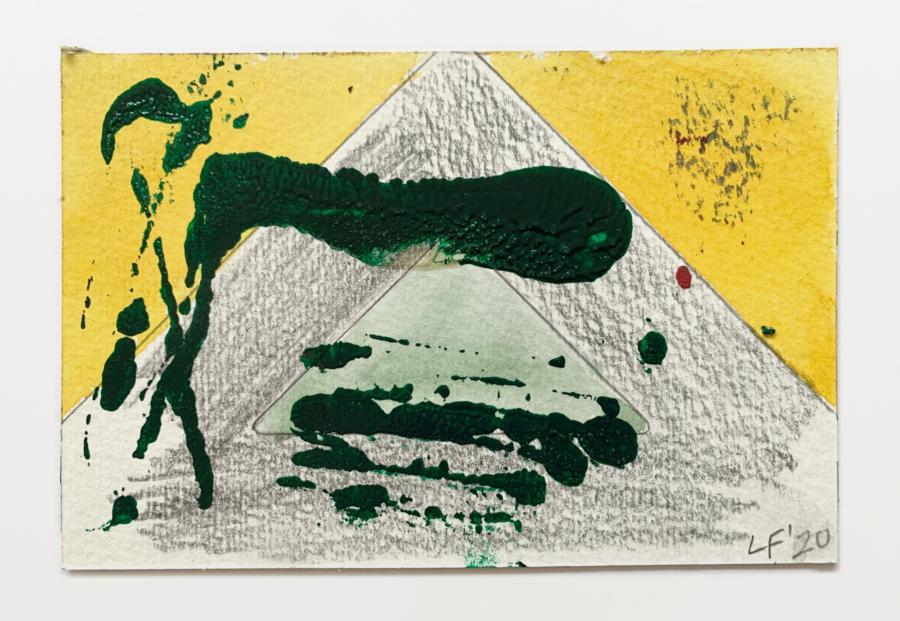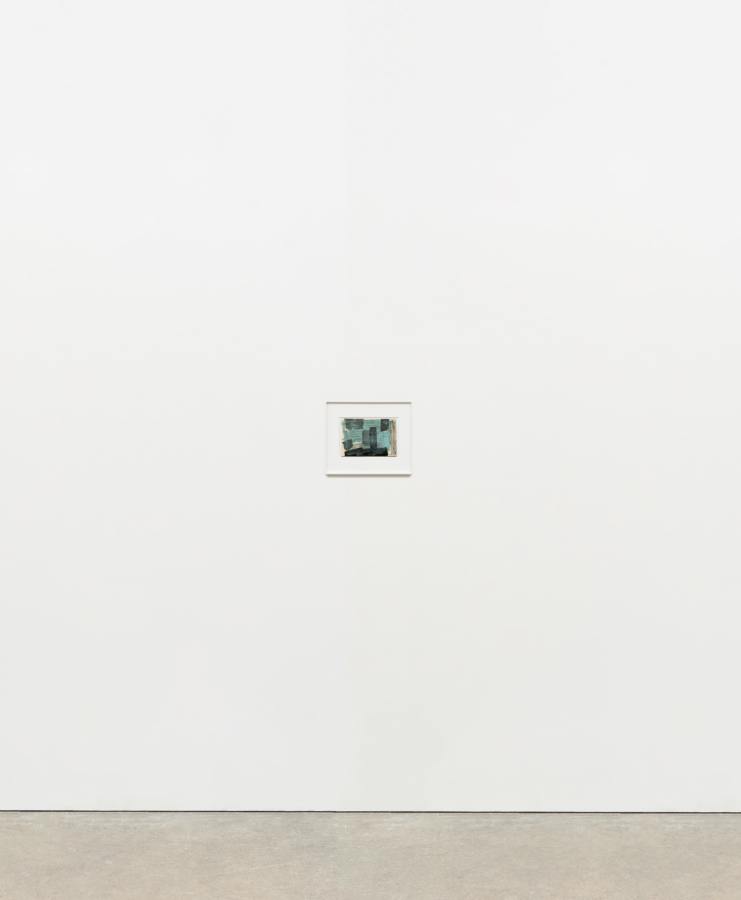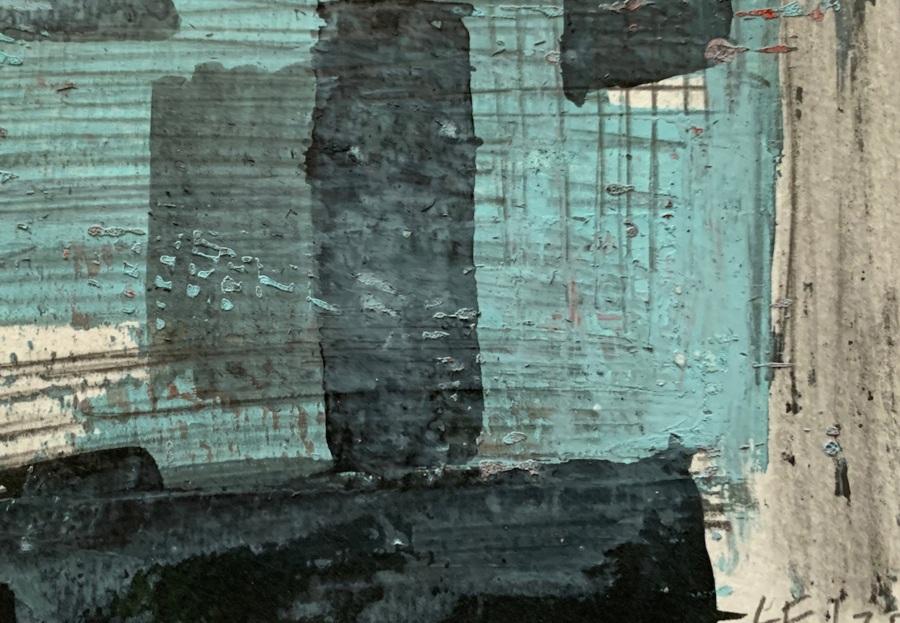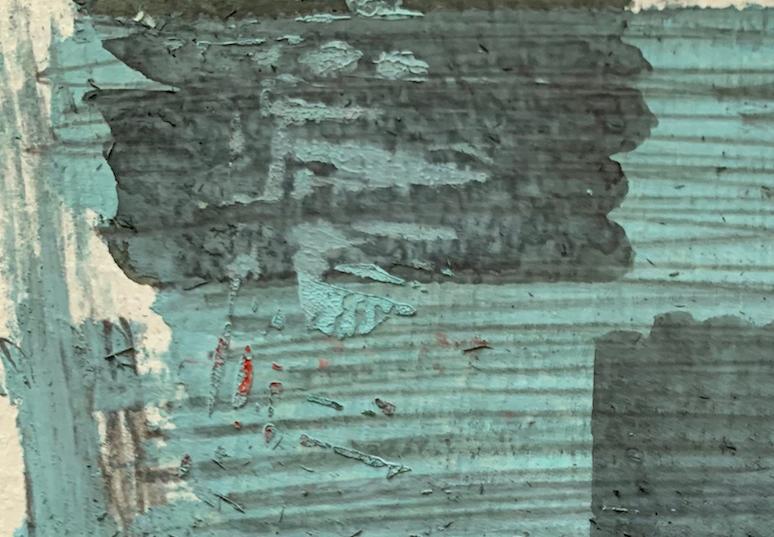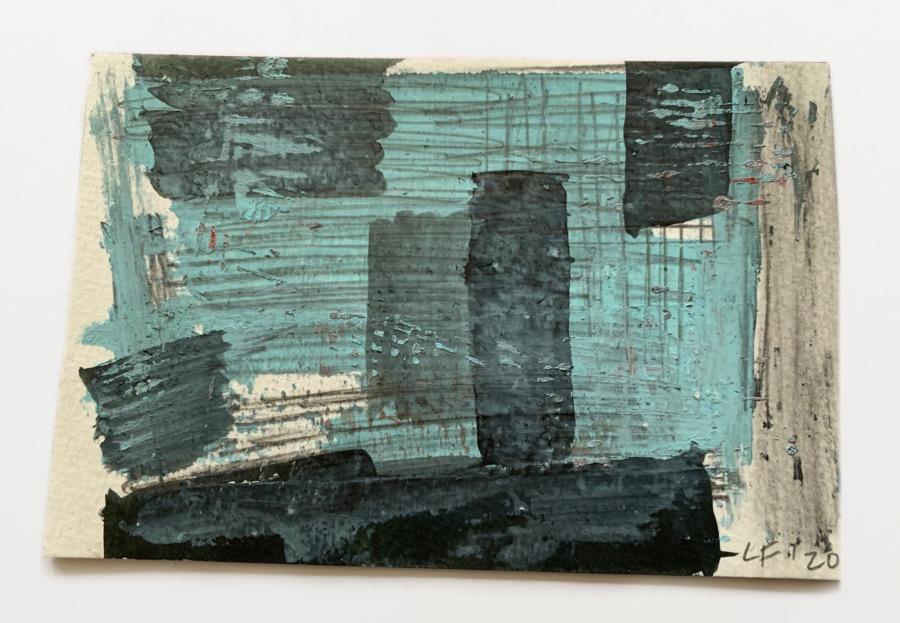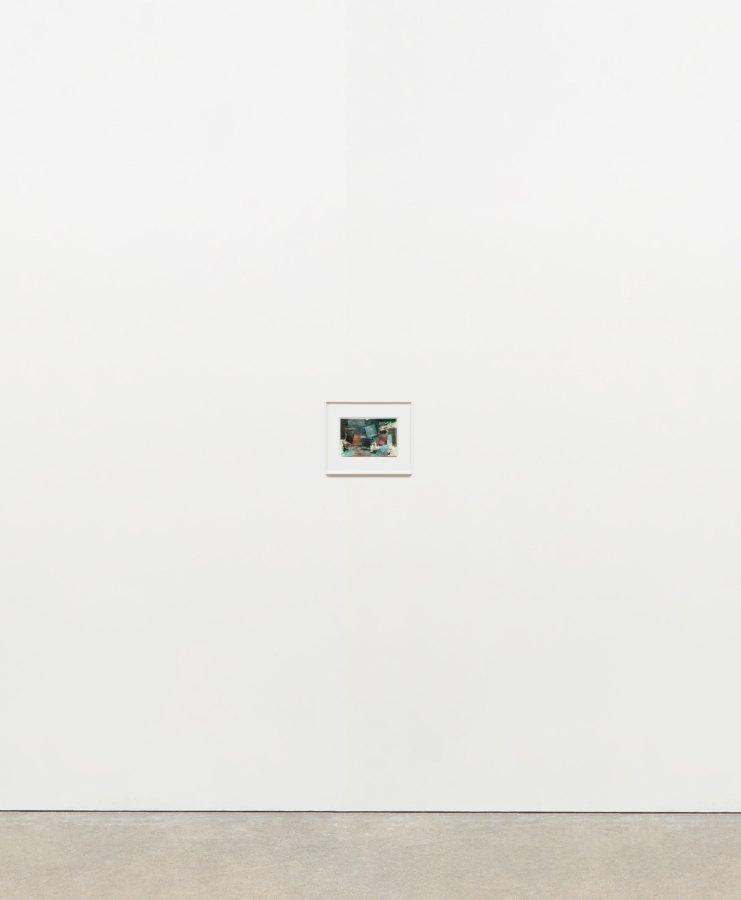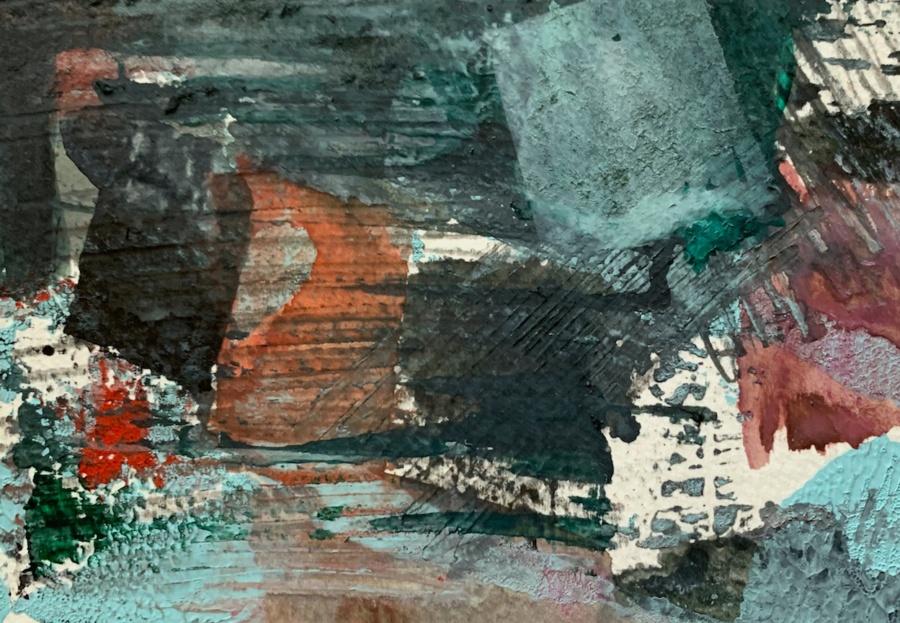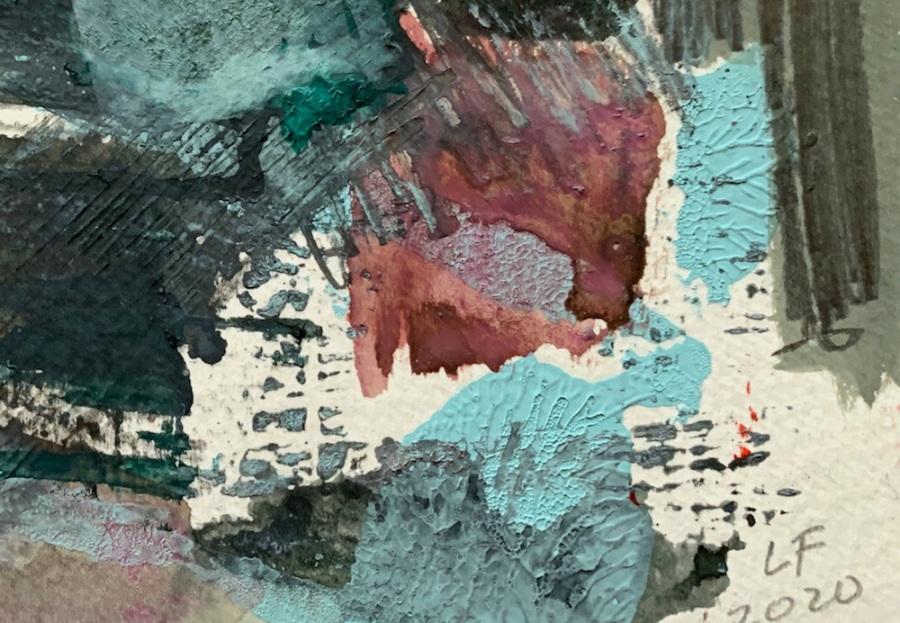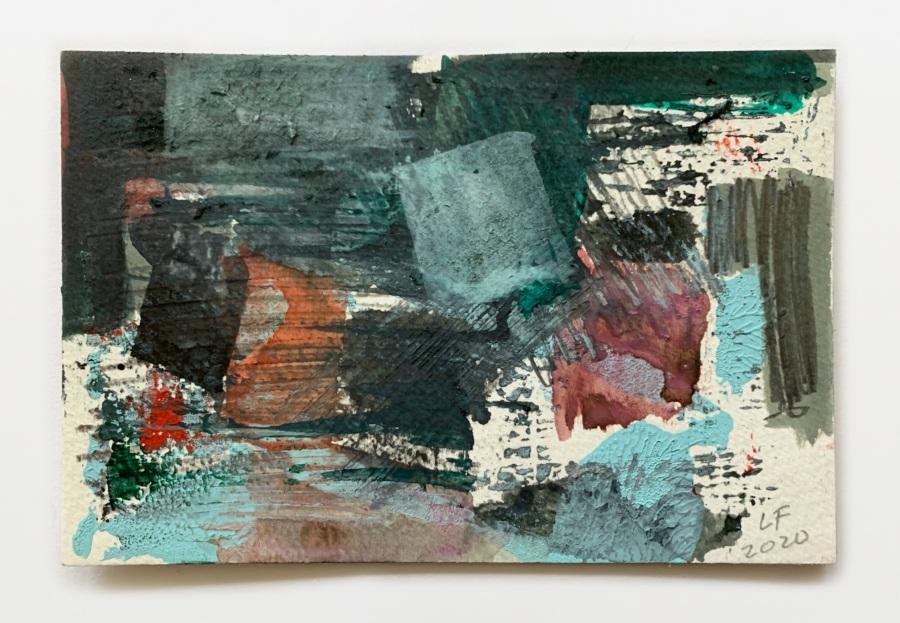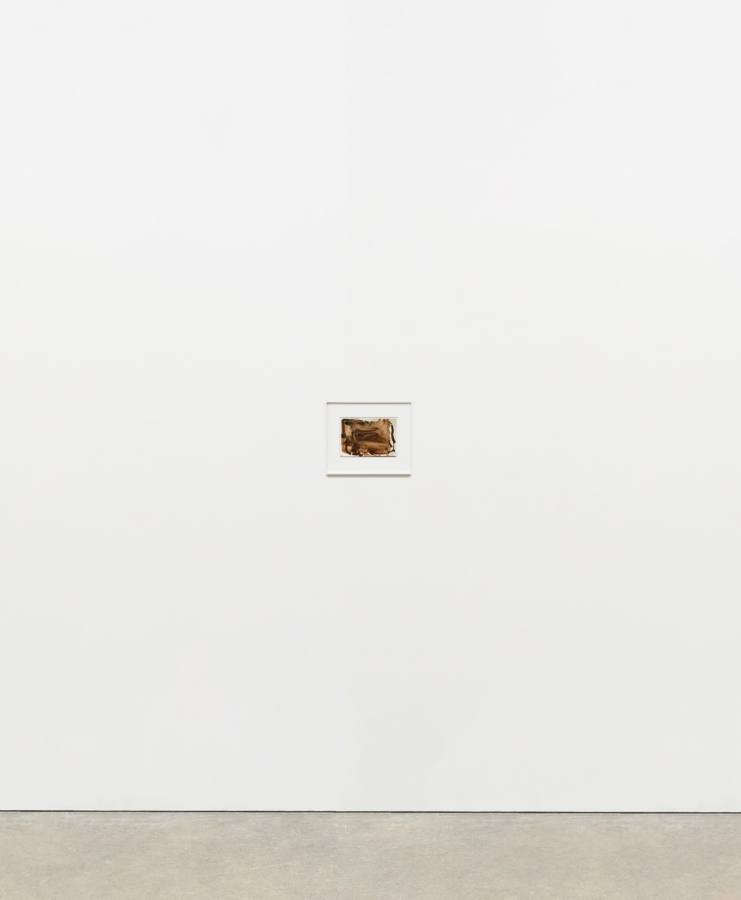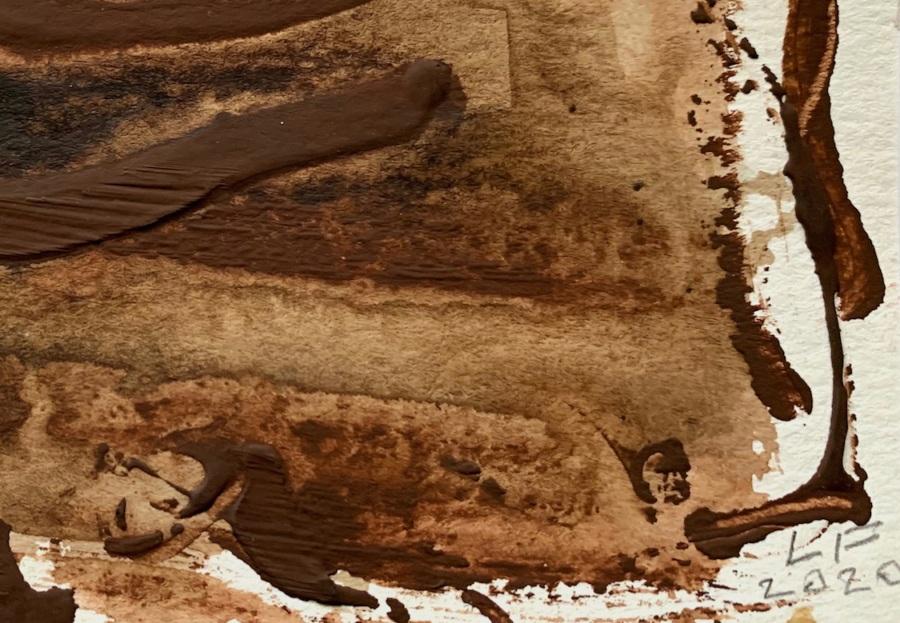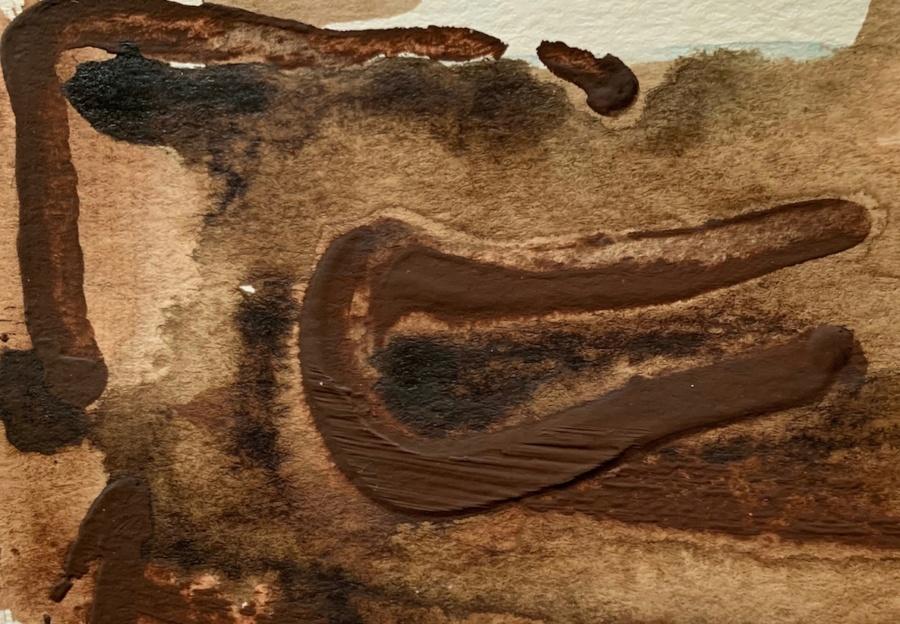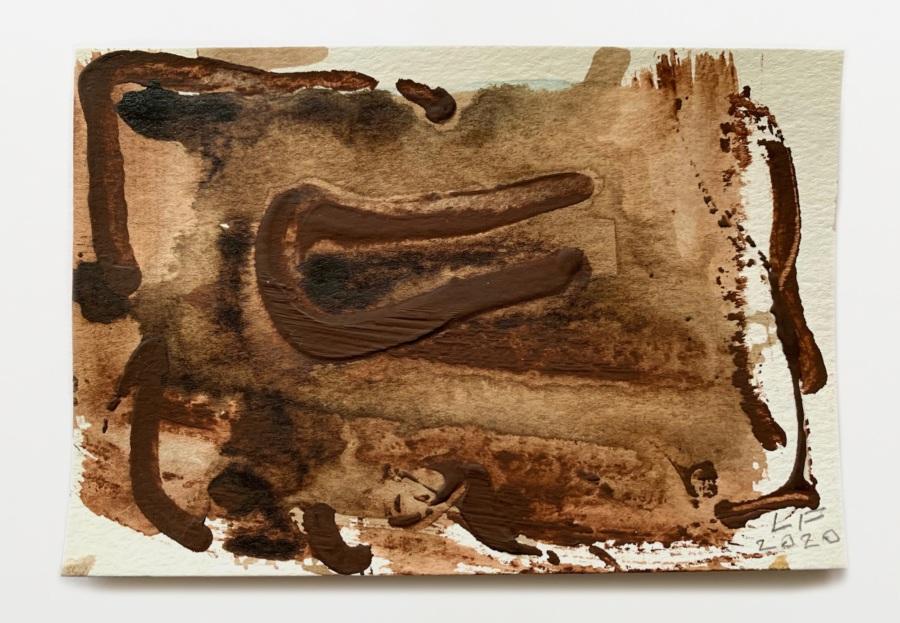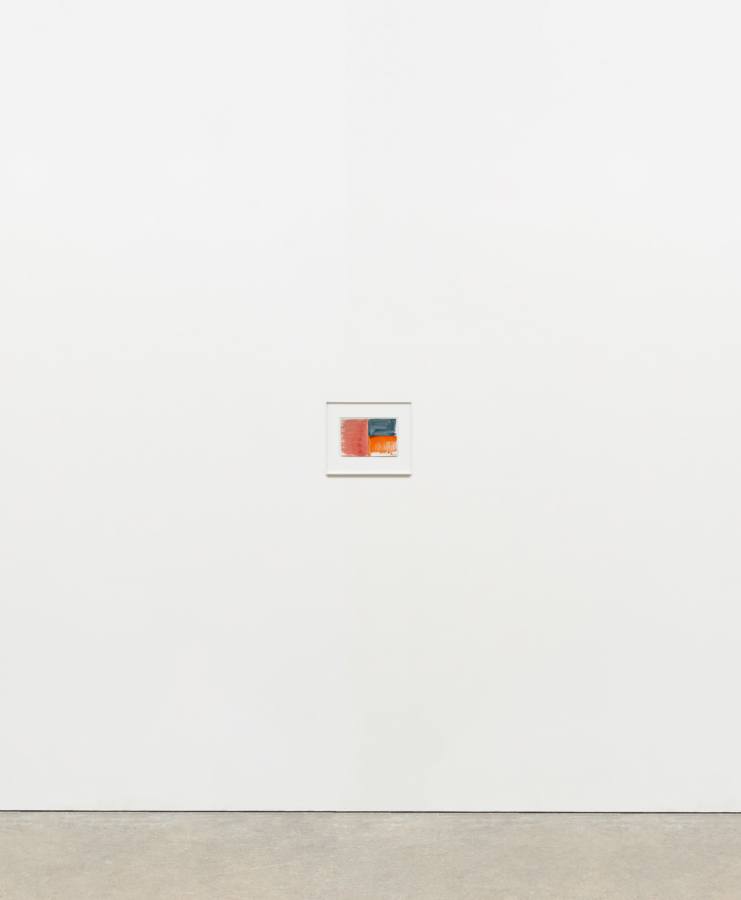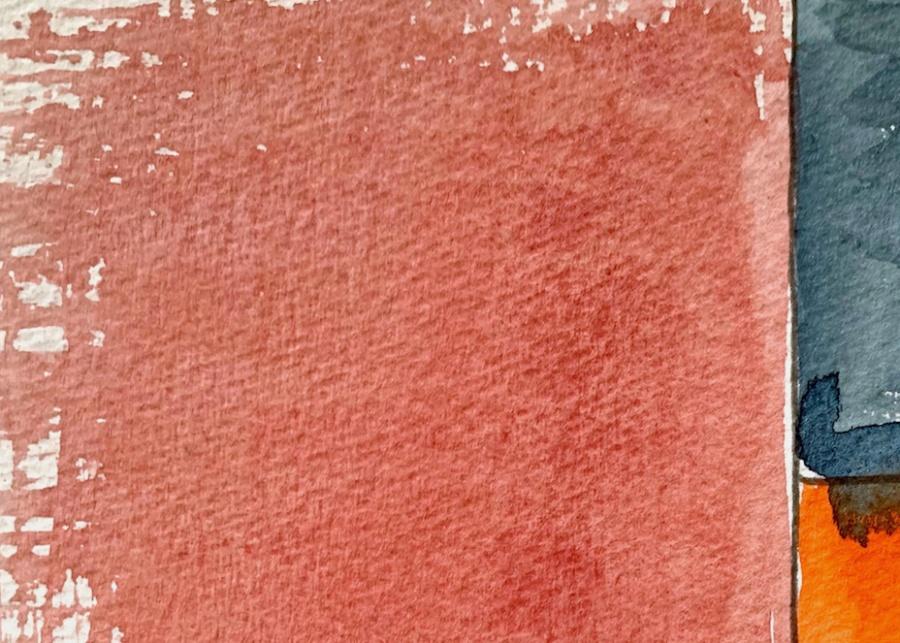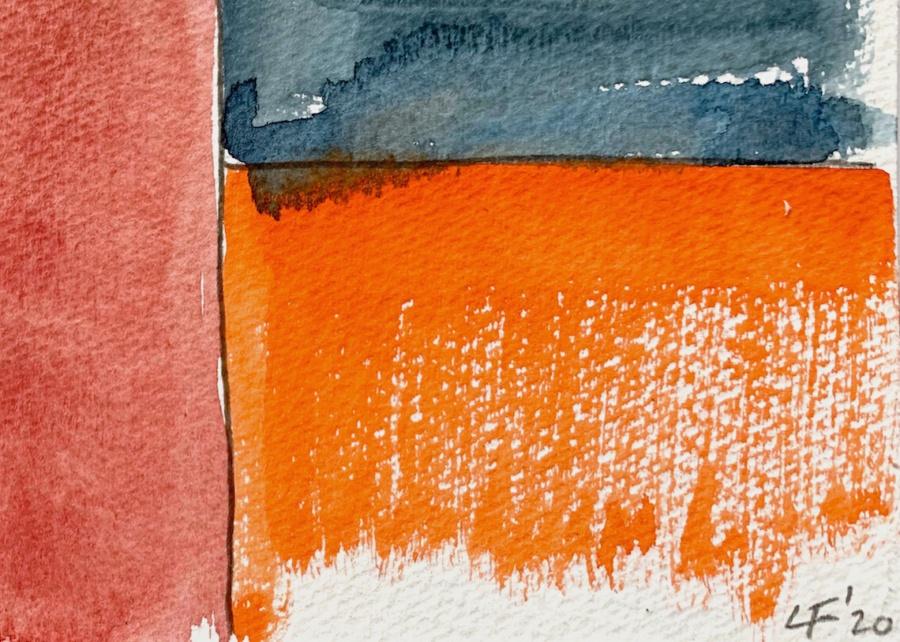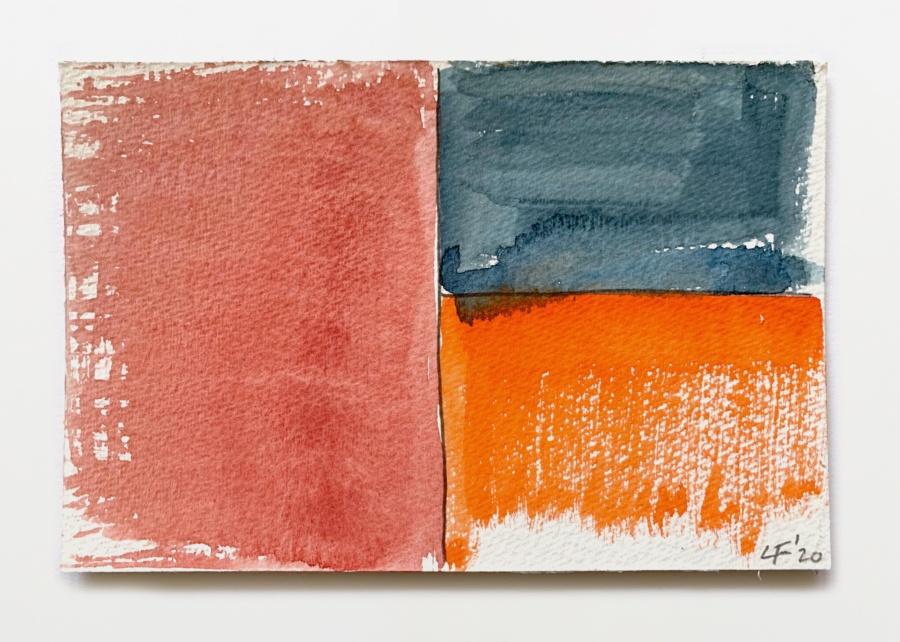9 WORKS ON PAPER
LOUISE FISHMAN
9 WORKS ON PAPER
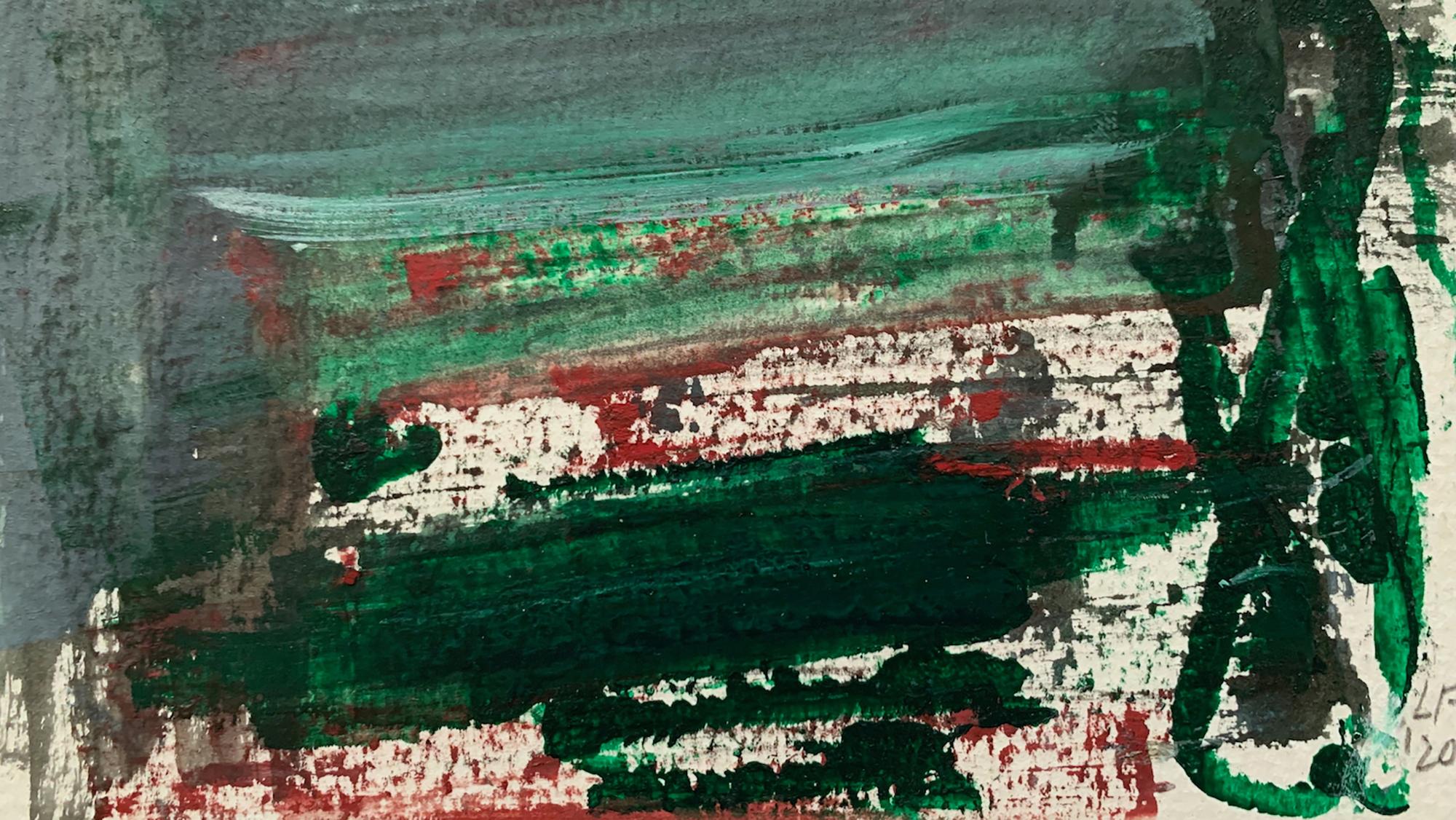
NOTES OF A COLOR COMMENTATOR
by Amy Sillman
9 INNINGS:
NOTES OF A COLOR COMMENTATOR
by Amy Sillman
Hello everybody, what a beautiful day for baseball! There’s some mild green traffic outside, a low-hanging chunk of emerald mud tilted up towards right field, and the grass is hooker’s green. We’re all wondering what to expect, and we are underway! Here comes Fishman, out to the mound! She’s a fireplug—a five-foot utility slinger, a northpaw with a real cannon, originally out of the Philly club with time spent in Illinois and now New York City. She’s known for really being in the paint: throwing out some gritty, cruddy, besmirched-looking stuff, but with static, some flounce and some bounce, and the result is a picture of motion. You never know, today she might go wild in the strike zone. Right now she’s throwing out fungo with a rugged clattering. Chunky, sullied, or proper, Fishman’s not likely to surrender any crooked numbers. And she’s reading signs as she goes into her windup: and BANG! Right out from under, a gray wedge grooves up the alley, tilting low and across, and HOLY COW, it’s a cement mixer, and it hits a receiver, an ear! What a dastardly thing that is—snake jazz! Green junk on the side, a hanging green snowman with low velocity but lots of movement. Looks like Fishman’s cancelling Christmas! Green on green don’t stand a chance, and the field is littered with shards of crimson. It’s a slinger! Gas, heat, hair, the jinegar express! Nothing gets by Fishman in a corner.
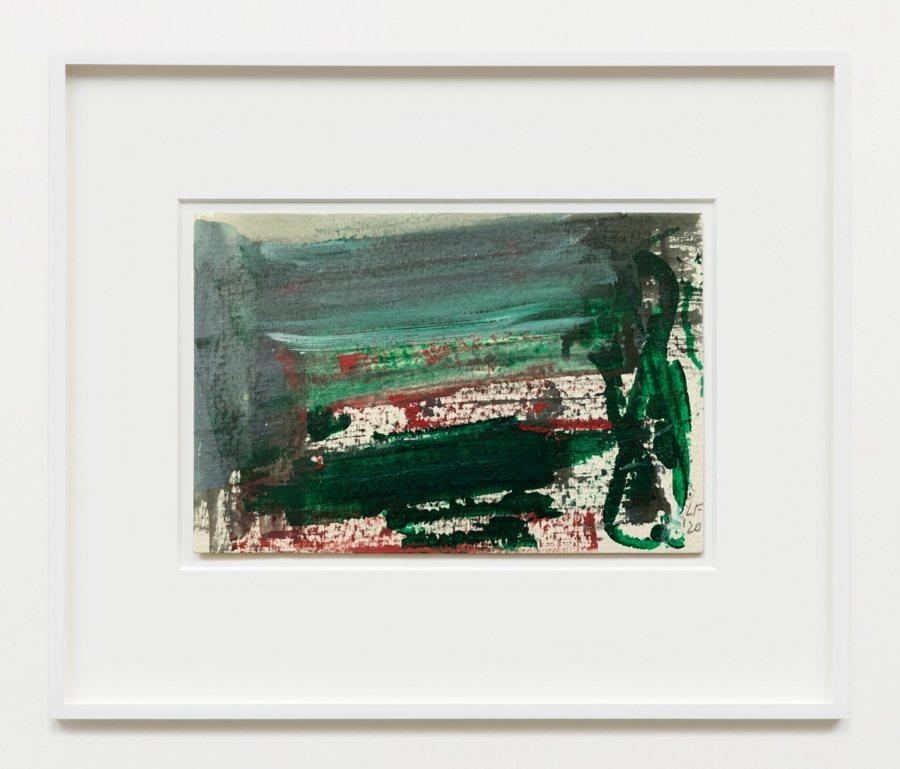
Louise Fishman
Untitled, 2020
Watercolor on paper
4 × 6 inches; 10.16 × 15.24 cm (unframed)
7 × 9 inches; 17.78 × 22.86 cm (framed)
LF-20-015
Louise Fishman
Untitled, 2020
Watercolor on paper
4 × 6 inches; 10.16 × 15.24 cm (unframed)
7 × 9 inches; 17.78 × 22.86 cm (framed)
LF-20-015
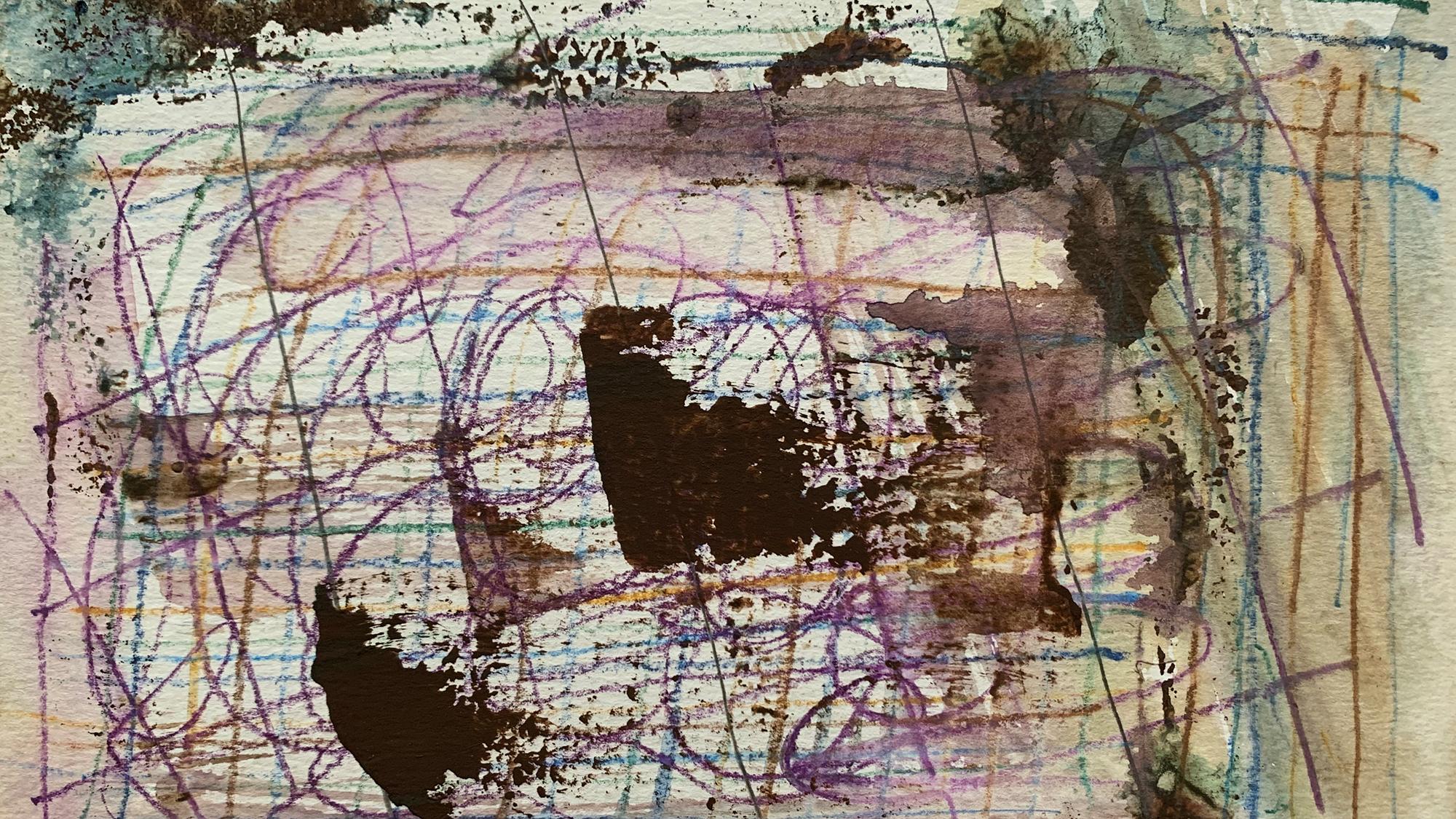
Fishman’s got stuff. There’s a nubber of grain holding up a corner high above left field, and blottings outside the right field zone. But look out! Fishman’s a powder keg! She throws out a side-armer starting high and away, a two-to-nine pitch, and whoa! What kind of action is this? It’s a vapor trail with a volume inside, or a chopper on the plains, low velocity but lots of movement. Fishman’s stratosphere is tumbling, a bloop cloud in slo-mo. You can lick a stamp, cuz this is heft meets airmail! Oh what a spine-tingling moment! She’s putting on a laser show—punchados of umber, excuse-me swings of dirty violet and dingy ochre cutting into the embroidery, a dependable turquoise board ticking underneath. This is a twin killing. What’s her secret? As she always says, hit ’em where they ain’t.
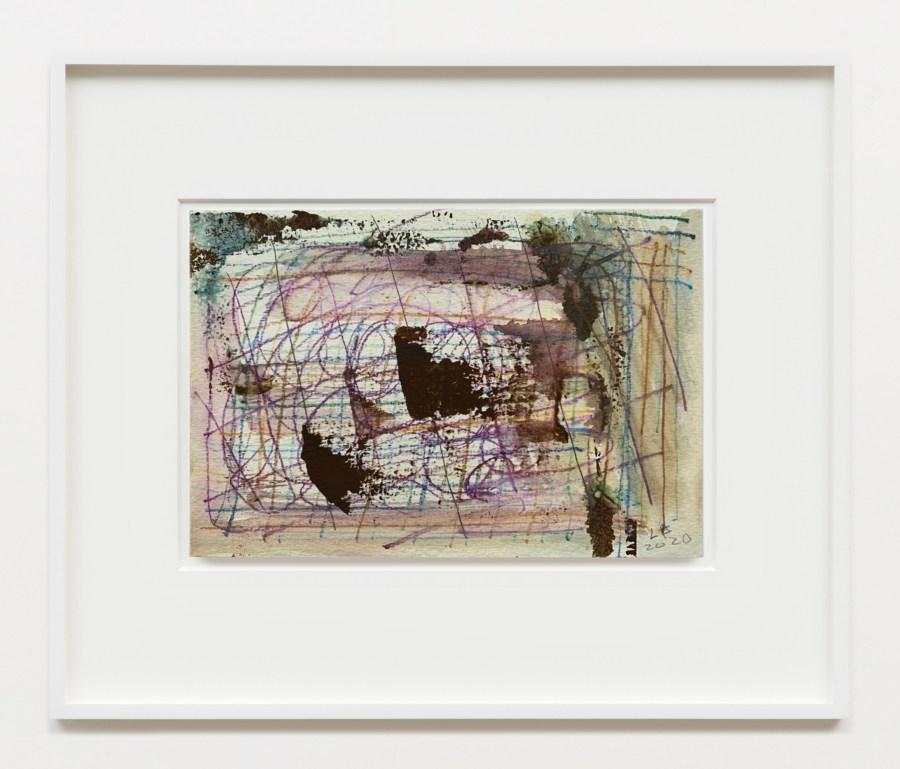
Louise Fishman
Untitled, 2020
Watercolor, color pencil, and pencil on paper
6 × 9 in; 15.24 × 22.86 cm (unframed)
9 × 12 in; 22.86 × 30.5 cm (framed)
LF-20-020
Louise Fishman
Untitled, 2020
Watercolor, color pencil, and pencil on paper
6 × 9 in; 15.24 × 22.86 cm (unframed)
9 × 12 in; 22.86 × 30.5 cm (framed)
LF-20-020
Fishman toes the slab and sets up. She’s painting the corner umber with tiny pops of aqua over to right field and far back of the strike zone, boxing them in behind the backstop. Wild combination: a sludgeball low and loose. I can read lips and she’s not praying. Fishman’s a heaver, sometimes sending out an ugly finder. She hits it high, she hits it deep. Give it to the butcher boy and get him home juiced, plunked, like a spilled rainbow. Fishman’s operating from her wheelhouse, with power gork, a blooper and a bleeder. Can I get a reservation for this?! Fishman’s a maestro, a real artist—why, this could be in an art gallery!
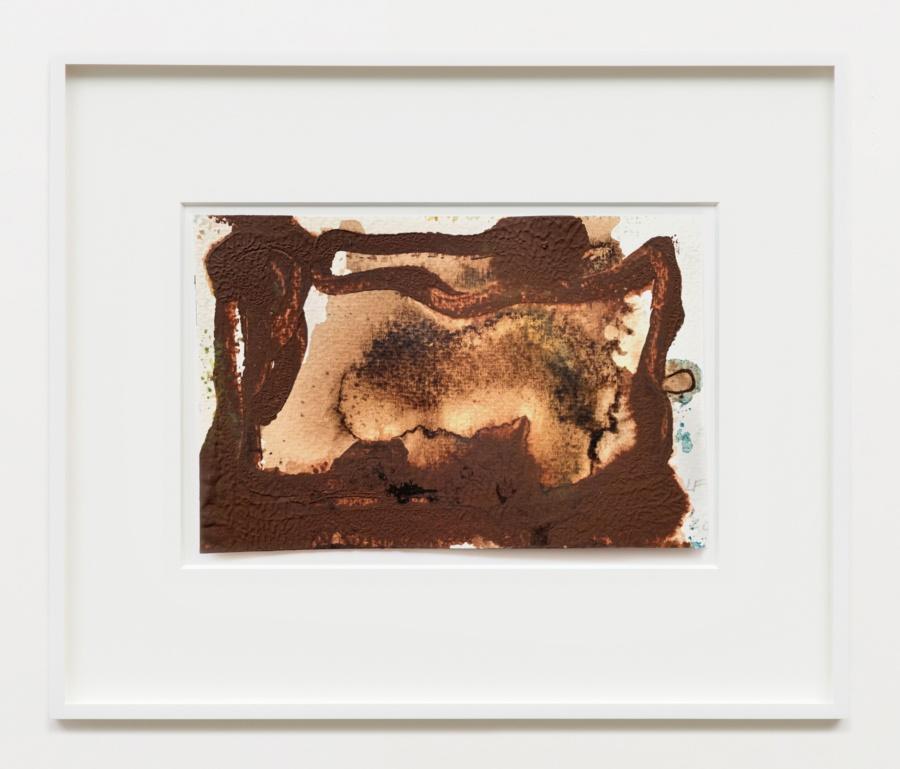
Louise Fishman
Untitled, 2020
Watercolor on paper
4 × 6 in; 10.16 × 15.24 cm (unframed)
7 × 9 in; 17.78 × 22.86 cm (framed)
LF-20-017
Louise Fishman
Untitled, 2020
Watercolor on paper
4 × 6 in; 10.16 × 15.24 cm (unframed)
7 × 9 in; 17.78 × 22.86 cm (framed)
LF-20-017
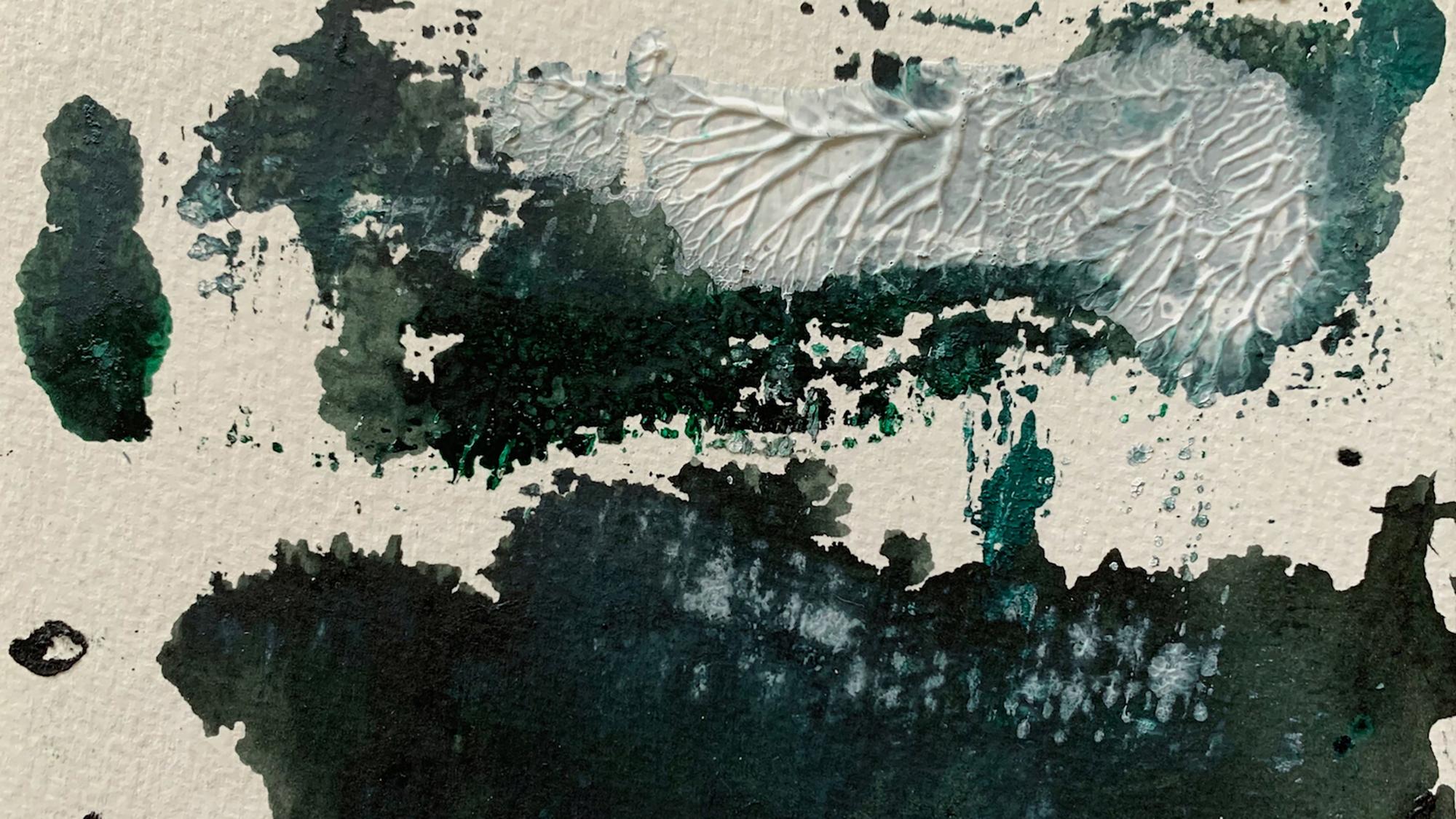
Fishman takes an extremely long stride to the plate and slings a darkness coming from up and under. Two flings, no hocus pocus, just focus: a green shadow and two bloops. The count is three and two. She’s squeezing the zone like a banjo hitter. A dark-green umber, shading to a cerulean, oh man, she’s got filthy stuff. The stains are in the shade. Gimme a tater, Louise…OH! It’s grounded to short. But Fishman is resourceful! Down the field it comes and look what’s coming up! She pastes an Eephus curve to the right! The game is on the board! Fishman’s crafty, she scored more: she threw out a dipsy-doodle, blew the greens open like a speed merchant, and shut the door on this situational stuff. A Lawrence Welk play, a one-two-three! Boo-yah! Light this baby up! Fishman votes the ball off the island.
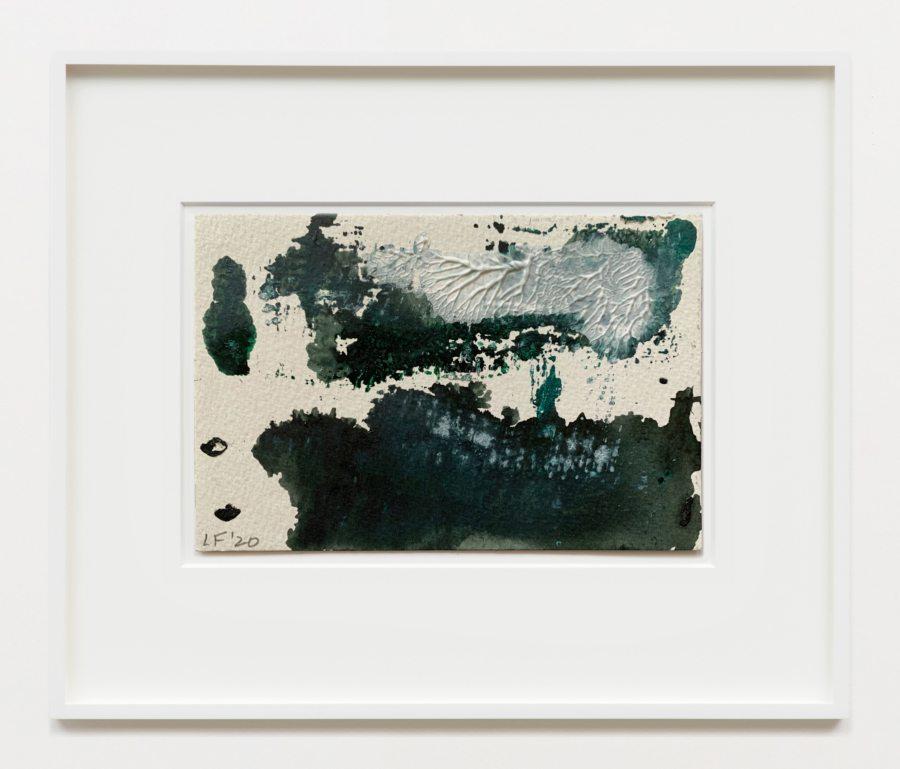
Louise Fishman
Untitled, 2020
Watercolor on paper
4 × 6 inches; 10.16 × 15.24 cm (unframed)
7 × 9 inches; 17.78 × 22.86 cm (framed)
LF-20-019
Louise Fishman
Untitled, 2020
Watercolor on paper
4 × 6 inches; 10.16 × 15.24 cm (unframed)
7 × 9 inches; 17.78 × 22.86 cm (framed)
LF-20-019
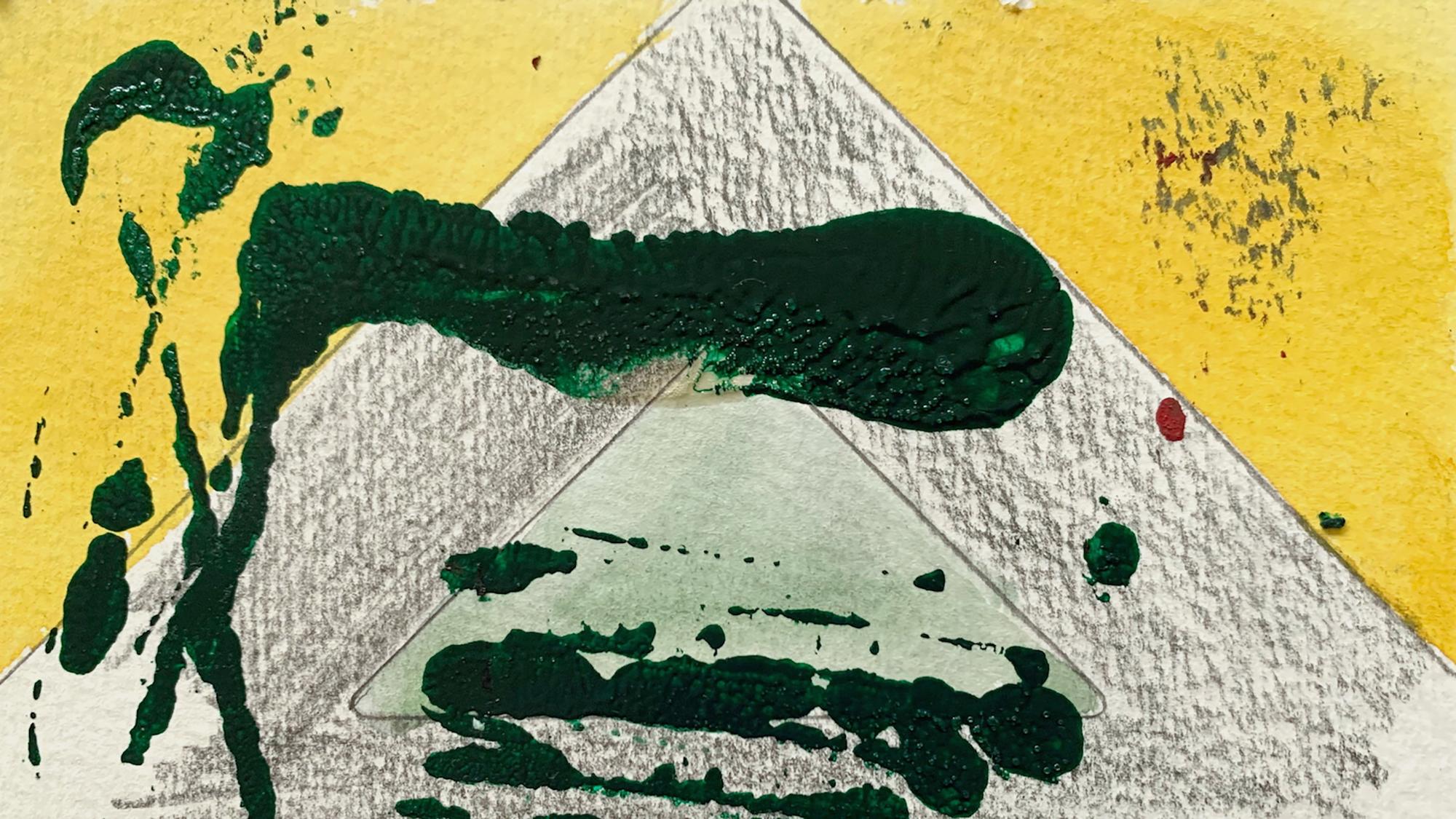
OH! Fishman’s in the hot corner now! Her howitzer is oiled. She’s cruising. This is a new game, high and tight. Now to her windup: and Fishman throws out some frozen rope, tight and sharp, with what looks to be the bagger right inside the five hole. It’s gonna be a zone play! She blows the outfield open, up top and down below. Fishman’s adding mustard. Grab some pine, meat! She’s off the schneid! A little off here, a little off there & you’re done, take a seat. She’s roughing in around home plate, no runners on board, but the ball itself is dialed up. And a crack of the bat: OH! Swung on and belted! It’s a big viridian grapefruit—Fishman’s bringing the juice back now! Clear the deck: cannonball coming! She grooves a head of lettuce up the elevator shaft, leaving only a tiny couple of pills of red on the right. There’s a herky-jerky marigold left in the outfield, even a smirch of emerald below. Is it five pitches or six? Cuz she is GONE!
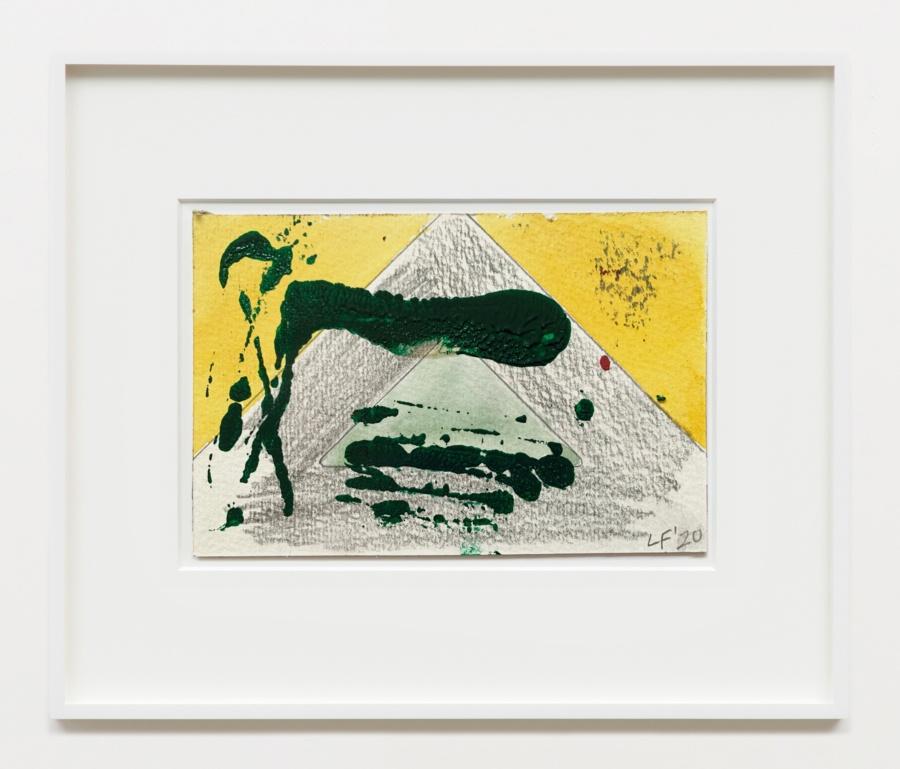
Louise Fishman
Untitled, 2020
Watercolor, pencil, and acrylic on paper
4 × 6 inches; 10.16 × 15.24 (unframed)
7 × 9 inches; 17.78 × 22.86 cm (framed)
LF-20-012
Louise Fishman
Untitled, 2020
Watercolor, pencil, and acrylic on paper
4 × 6 inches; 10.16 × 15.24 (unframed)
7 × 9 inches; 17.78 × 22.86 cm (framed)
LF-20-012

Fishman is throwing out a clinic in this round. A thin gray wash hems in the far right field while Fishman holds everything else down from the mound, a solid slab of pitch that extends out from the base to where it ends with a fat ripple. She defines the strike zone with some Philly chop, malachite, the color of someone’s eyes, that pulls across the field all the way to the edge of left field, but not quite over it. Scratchy as it goes but with a gust. You can almost taste the pressure now. Fishman lifts her cap and runs her fingers through her gray hair. Then five strong pitches away and wide, choppers, coming into play from off the field, three vertical slats and two slabs torqued into diagonal, of varying solidity—from skyscraper-tight to the kiss of a dinghy. Holy cow, this is weather all over the field, from here to yonder, way past the back wall. Fishman’s thrown out a vertical scrim, a weather system of interference, hail—this is no grid for measuring—it’s a tonal net! Like a hair net. Fishman’s putting on a crooked number, covering her bases, and her knuckler is dancing. We’re in trouble. She really put it away in this one, this is real fancy stuff.
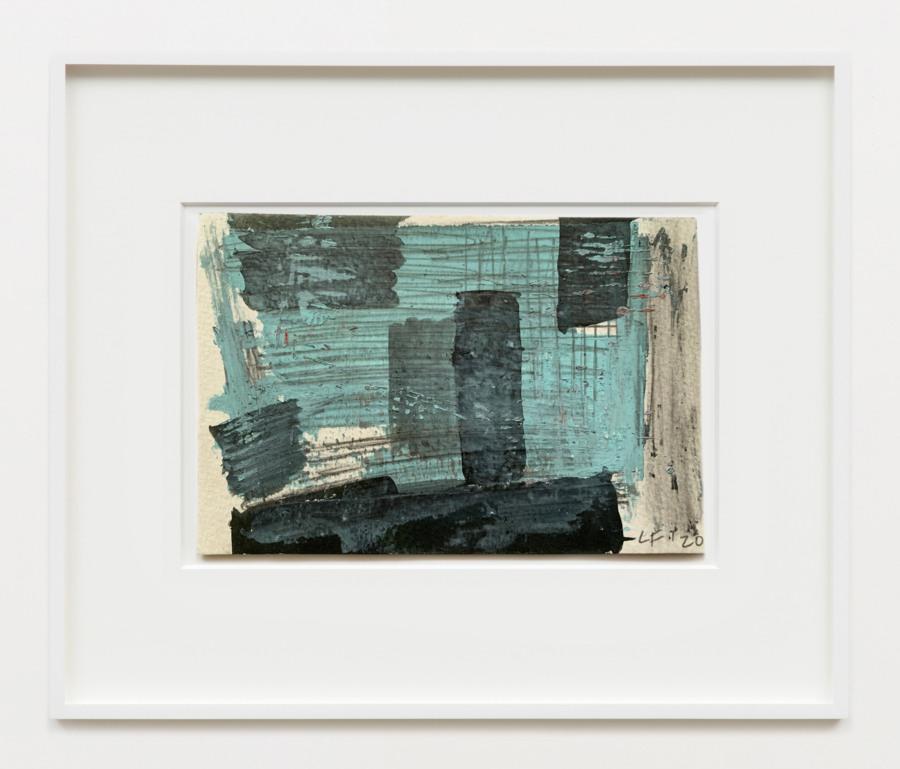
Louise Fishman
Untitled, 2020
Watercolor, ink, and pencil on paper
4 × 6 inches; 10.16 × 15.24 cm (unframed)
7 × 9 inches; 17.78 × 22.86 cm (framed)
LF-20-016
Louise Fishman
Untitled, 2020
Watercolor, ink, and pencil on paper
4 × 6 inches; 10.16 × 15.24 cm (unframed)
7 × 9 inches; 17.78 × 22.86 cm (framed)
LF-20-016
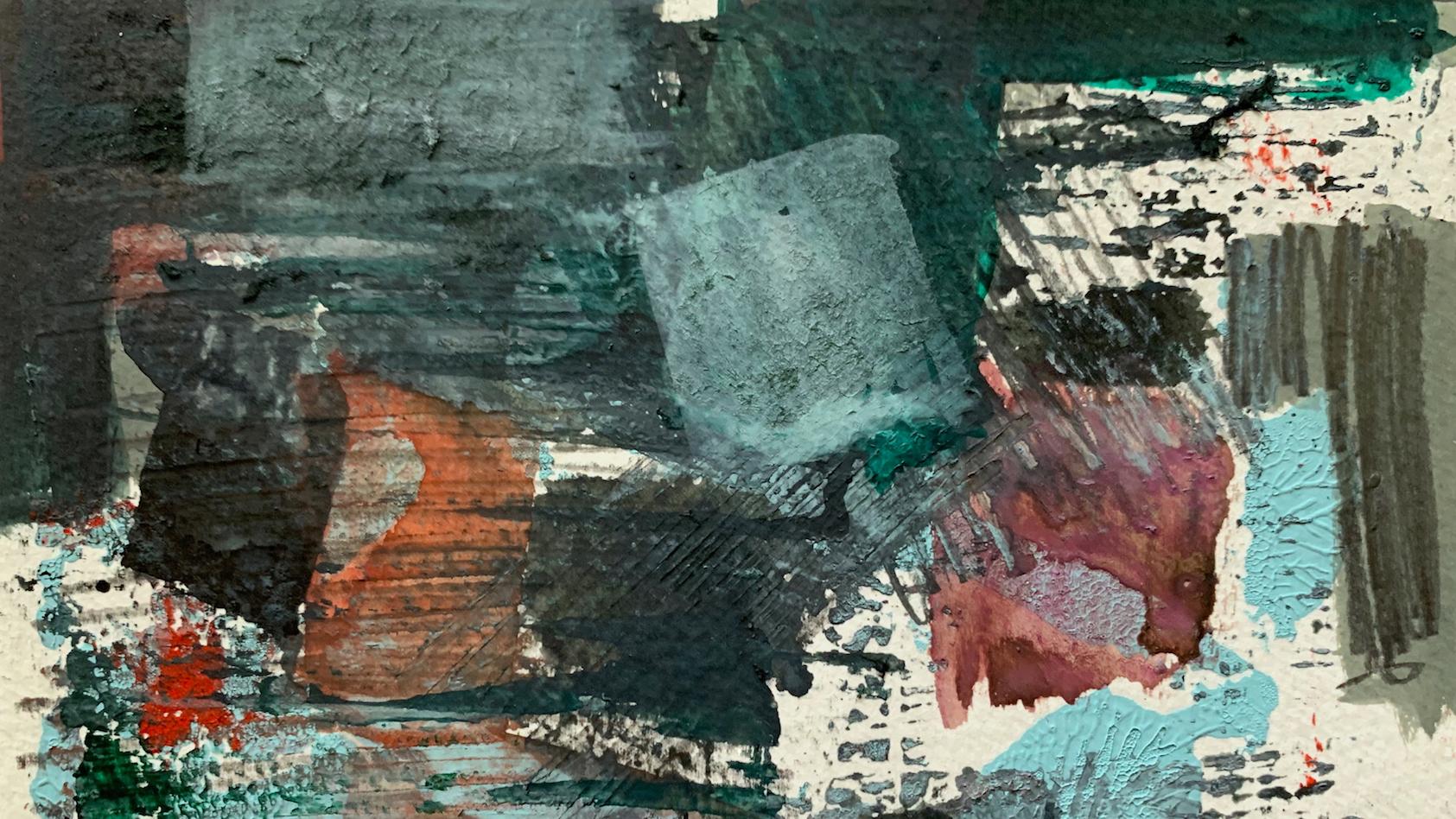
Things are breaking open. Fishman’s mad now, spitting magic words and throwing out fast junk. She’s pasting yakkers, wrinkles, zigzaggers, and pretzels. She’s putting the hurt on the paper, and this time with emergency hack. Oh my! She’s juiced, she’s ripping it, and it’s off the wall! She’s in the catbird seat, now going deep—no! She started to go after it but said no ma’am. No slump here, send me a slurve! Now Fishman’s belting out her biggest number: and it’s nothing less than salami! OH! She drills deep to left. Are you serious? OUCHTOWN! Population: you! Fishman, the savior of misbehavior, is rumbling, bumbling, and stumbling. Get outta here!
(the 7th inning stretch)
Stretch, stretch, stretch. What’s your excitement level? Eight million people are watching and a million have butterflies in their stomachs.
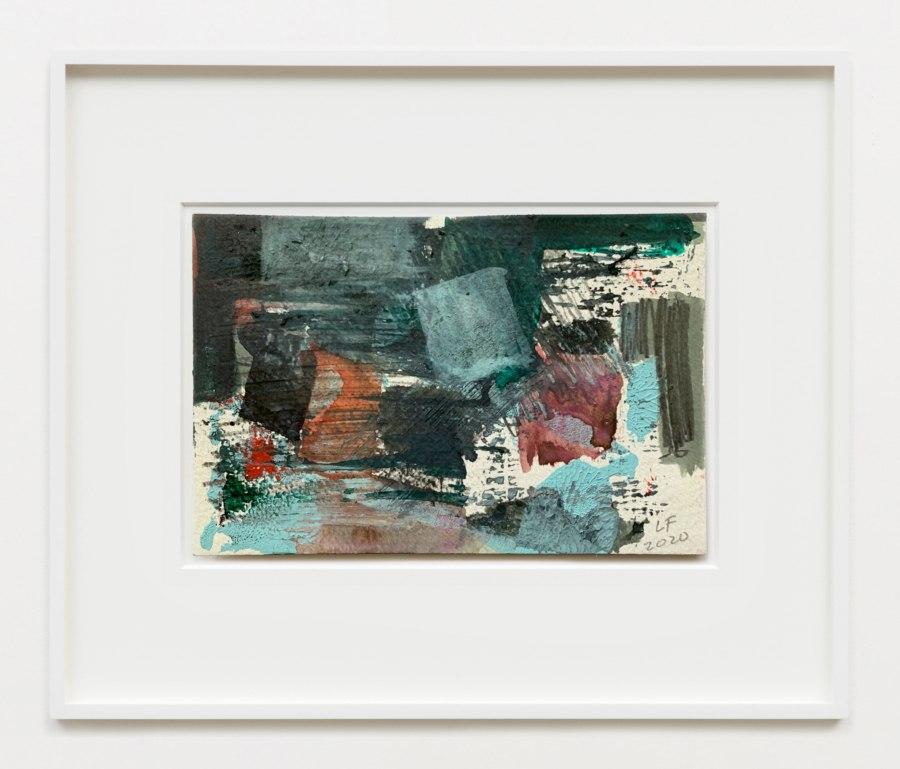
Louise Fishman
Untitled, 2020
Watercolor and pencil on paper
4 × 6 inches; 10.16 × 15.24 cm (unframed)
7 × 9 inches; 17.78 × 22.86 cm (framed)
LF-20-014
Louise Fishman
Untitled, 2020
Watercolor and pencil on paper
4 × 6 inches; 10.16 × 15.24 cm (unframed)
7 × 9 inches; 17.78 × 22.86 cm (framed)
LF-20-014

Fishman strides out to the mound and here’s the pitch: she slings a fastball to left field, then follow a flurry of twelve short hacks. She’s aiming the ball and belting it down the stretch, and here they come: flashing the leather. Her deal is a douze, and these are no cookies! Off to the right she will not have play. This is a rally, with a dozen Fishman bazookas sliding past the batter’s eye. She’s way ahead in the count, and she’s doctoring the ball, and—OH! How she’s hurling! Look at that thing go—if that were a fish you’d throw it back, but it’s not a fish! It’s a slutter, a brown weenie sent right down the middle of the plate! Fishman comes from way downtown: looks like she was waiting for the local but caught the express!

Louise Fishman
Untitled, 2020
Watercolor on paper
4 × 6 inches; 10.16 × 15.24 cm (unframed)
7 × 9 inches; 17.78 × 22.86 cm (framed)
LF-20-018
Louise Fishman
Untitled, 2020
Watercolor on paper
4 × 6 inches; 10.16 × 15.24 cm (unframed)
7 × 9 inches; 17.78 × 22.86 cm (framed)
LF-20-018
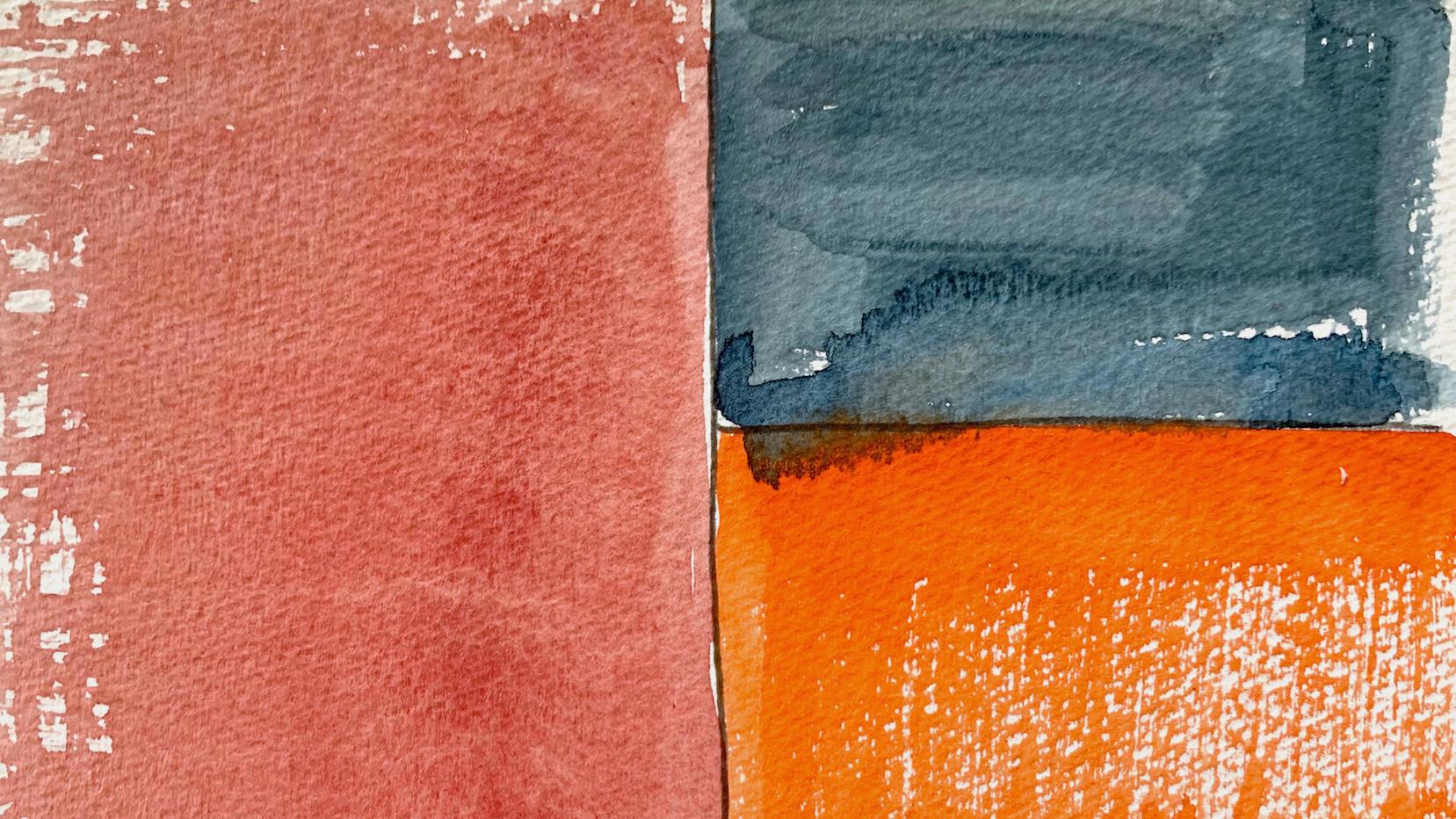
Fishman’s a box artist so this oughtta be good, but she’s not in a windup yet. You can’t blame a woman for pushing just a little bit now: at a moment like this, the mound is the loneliest place in the world, but she’s as cool as the other side of the pillow. Fishman shakes herself a little bit, hitches up her belt, and toes the rubber. Looks in to get a sign, one away from the promised land. The time on the scoreboard is 9:44 a.m., the date is April 27, twenty-twenty. That’s gone on notice. Wait a minute: Woah Nelly! Fishman’s painting wide ones, and they’re heading for orbit! HOLY COW! On a scale of one to Louise Fishman, boom goes the dynamite, and she hit it on the screws. They say this is a man’s game, but it’s Goodbye Mr. Spalding. She eyed it, she tried it, and she buyed it! You can write her name in capital letters, the F stands out and then the ISHMAN. She just shut the door, and doctor, you can hang a star on that one. Raise the Jolly Roger and light up the board, cuz this baby is gone. Goodbye! See ya! But don’t ask me anything else about it: I’m just a pink hat.
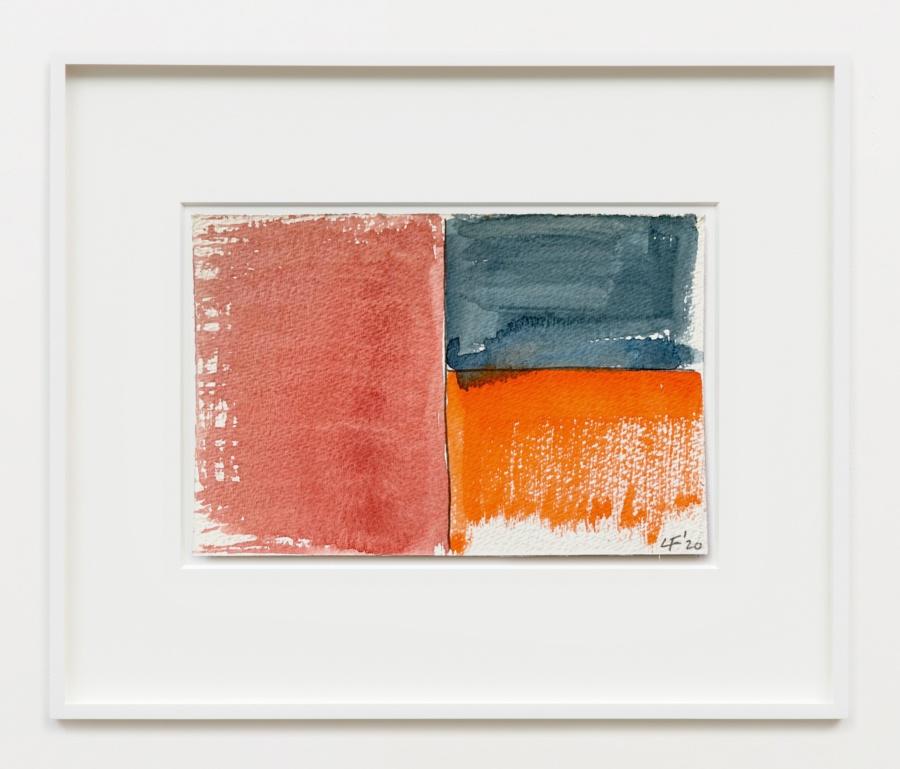
Louise Fishman
Untitled, 2020
Watercolor and pencil on paper
4 × 6 inches; 10.16 × 15.24 cm (unframed)
7 × 9 inches; 17.78 × 22.86 cm (framed)
LF-20-013
Louise Fishman
Untitled, 2020
Watercolor and pencil on paper
4 × 6 inches; 10.16 × 15.24 cm (unframed)
7 × 9 inches; 17.78 × 22.86 cm (framed)
LF-20-013
by Gilles Heno-CoeLOUISE FISHMAN: OFF THE GRID
by Gilles Heno-Coe
Packed into the space of four by six inches, Louise Fishman’s recent watercolors deliver the same graphic punch and material splendor of her larger oil on linen paintings. As fellow painter Suzan Frecon has perceptively written about Fishman’s work, “dense heavy impastos interweave with faint and delicate touches. One can perhaps think of musical dimensions while trying to describe them.” 1 In ways that hardly seem possible for this humble medium, Fishman deftly commingles casual ochre washes with thick, heavily textured passages of steely blues and dark greens, occasionally interspersed with smoldering patches of crimson to set the tiny sheets ablaze (Fig. LF-20-014).
Like other painters of her generation, notably the late Jack Whitten, Fishman dissolves and humanizes the minimalist grid, merging order with spontaneity, plan with accident. As Fishman wrote in 1977, “I try to take the painting by surprise. I begin as if accidentally (although all the while I have been sneaking glances at the work).”2 This motivation is evident in works like Untitled (2020) (Fig. LF-20-020): with its subtle evocations to a musical score, its irregular, off-kilter grid tries in vain to restrain vigorous swirls of magenta, phthalo green, and manganese blue underneath. The whole composition is punctuated by the assertive finality of a few quick, gestural notes of burnt sienna on top.
Having freed herself from the often prescriptive dogmas of the 1960s about modernist painting and abstraction, Fishman forged a highly personalized, process-based practice. She was loosely aligned with a group of artists imperfectly labeled “postminimalist” by art historian and critic Robert Pincus-Witten in the early-1970s. Works which at first seem like homages to hard-edge predecessors like Robert Mangold or Ellsworth Kelly (Figs. LF-20-012 and LF-20-013) either find themselves stained with thick globs of dark paint, or are playfully irreverent—with their meandering lines and casual washes—in their refusal to be hemmed in by established geometries.
For those familiar with Fishman’s work, her material subtlety and sophistication come as no surprise. Since the 1970s, Fishman has forged a singular practice informed both by her identity as a lesbian and by her passion for modern art and techniques. Fishman confidently proclaimed in 1977 that, “If good painting is what you want to do, then good painting is what you must look at. Take what you want and leave the dreck.”3 For Fishman, this meant taking the relevant bits from Paul Cézanne or Willem de Kooning, as much as from Agnes Martin or Eva Hesse. The pursuit of individual freedom and personal expression was and remains her primary motivation as an artist.
Fishman, discussing the positive impact of Hesse’s work on her practice in the early 1970s, reveals that, “At that moment, I decided I could do anything I wanted to as an artist, use any material I wanted, make sculpture, etc. Limitations were off.”4 For Louise Fishman, as with Eva Hesse, art making was not a zero-sum proposition, pitting one’s politics or identity against formalism or aesthetics. There was a way to have your cake and eat it too. Through materiality, these two artists explored aspects of their human physicality, aestheticizing both in the process. Fishman’s watercolors partake of the same physicality characteristic of her early multi-media constructions as well as her more recent large-scale paintings.
Some of Fishman’s new watercolors seem archeological or even geological, as sedimentary layers compacted with stony fragments from long ago civilizations (Fig. LF-020-016). Others evoke comparison to the desiccated puddles from which primordial lifeforms first crawled from water onto land (Figs. LF-20-017, LF-20-018). As critic and poet John Yau has written about her work, “Fishman replaces illusionistic space with a layered space, one which has been scraped, dug up, and partially covered over. If the body analogy holds in her paintings…it is because she has connected the body to the earth and ultimately to history and its repeated conflicts and conflagrations.”5
Fishman’s watercolors, much like her paintings, are not works “about” various aspects of her layered history and identity, but rather personal expressions of her embodied experience as someone fully living life. As art historian Richard Shiff has recently written about Eva Hesse, “Rather than referential significance, Hesse’s mark had life. Whose life? What life? An artist’s mark is a go-between, figuring the life of the paper as well as the life of the person.”6
Although intimate in size, Fishman’s watercolors are palpable indices of this very same dual-figuration—merging both figure with ground and art with life—and seduce even reticent viewers to take a closer look. At what point does vision yield to something more like remote touch? Without giving a definite answer, the watercolors pose this question wordlessly, purely through their sensory play of colors and textures on paper.
(1) Suzan Frecon, “Traveling in Louise Fishman Terrain,” in Turps Banana, Issue 17 (January 2017): p. 40.
(2) Louise Fishman, “How I Do It: Cautionary Advice from a Lesbian Painter,” in Heresies: A Feminist Publication on Art and Politics, Issue No. 3 (Fall 1977): 74.
(3) Ibid.
(4) Louise Fishman with Inge Pett, “‘Always Wild at Heart’—An Interview with Louise Fishman,” Yeast—Art of Sharing, February 17, 2017. <http://www.yeast-art-of-sharing.de/kunst/always-wild-at-heart-an-interview-with-louise-fishman/>.
(5) John Yau, “Why There Are Great Women Artists,” in Louise Fishman. New York: Cheim & Read, 2000, n.p.
(6) Richard Shiff, “To Draw Is To Ground,” in Edouard Kopp, John Elderfield, Richard Shiff, Terry Winters. Drawing Is Everything: Founding Gifts of the Menil Drawing Institute. Houston: The Menil Collection, 2019, 41.
